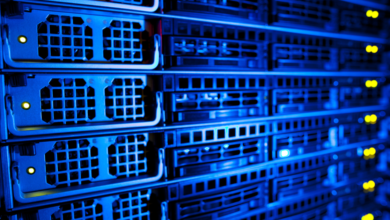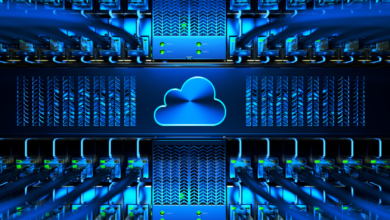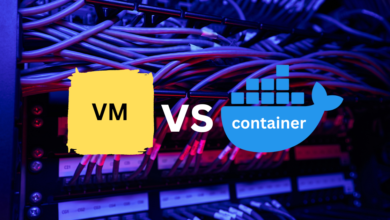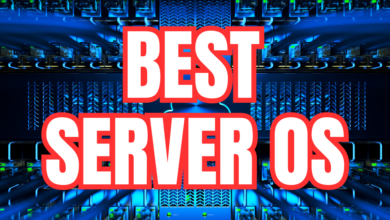Synology Active Backup for Business – Best Home Server Backup
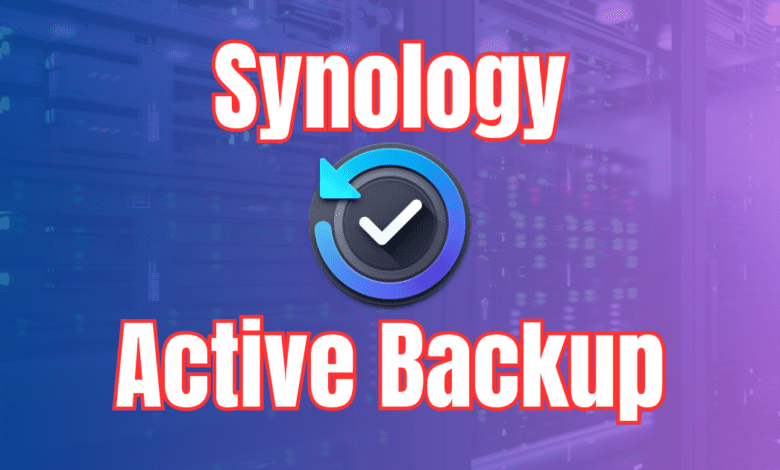
One thing you will want to do when you get to a certain stage of your home lab is to have backups and an overall backup strategy for DR to reduce risk. Backups help you recreate configurations and important data if those are lost. If you already own a Synology NAS device, one software app that you own and may not realize is one of the best backup solutions around for home lab or small business Active Backup. Not only can you perform a bare metal backup of physical servers and workstations to your Synology storage, but you can back up your virtual machines and applications running in the lab as well. Let’s see how to install Active Backup in Synology and how to configure backups.
Table of contents
- Synology Active Backup brief overview
- 1. Installing Synology Active Backup for Business
- 2. Backing up a virtual environment with Synology Active Backup
- 3. Creating a backup job
- What are Active Backup templates?
- Why using a NAS is great for disaster recovery
- Active Backup agent and Windows
- Wrapping up Synology Active Backup for Business
Synology Active Backup brief overview
Synology Active Backup suite is a backup solution that provides companies or home labs with active backups and centralized data protection for various environments either directly with the hypervisor API or using the Active Backup agent for physical workloads like a bare metal server or PC. It provides many business continuity benefits for environments including:
- SMB file server/rsync synchronization
- Nutanix/Netapp
- Mac
- Windows
- Linux
- Hyper-V
- VMware ESXi
It also allows you to have a self-service restore portal for end-users who have experienced data loss if you are using it in the realm of small business environments.
Synology Active Backup features
- Unified dashboard that allows configuring and monitoring backup tasks
- Reporting and notifications to create and view customized reports
- Quick installation and configuration with backup templates
- Incremental backups and deduplication for storage efficiency
- Recovery media for bare metal recovery
- Bandwidth controls and scheduling to manage bandwidth during off-peak hours
- Encrypted backups to make sure your data contained in the backups is safe
- Role-based access and admin delegation to control who and what actions can be performed
1. Installing Synology Active Backup for Business
Installing Synology Active Backup for Business package is a simple task in the Synology’s Package Center. Log into your Synology DSM console and navigate to your Package Center. Search for “Active Backup for Business”.
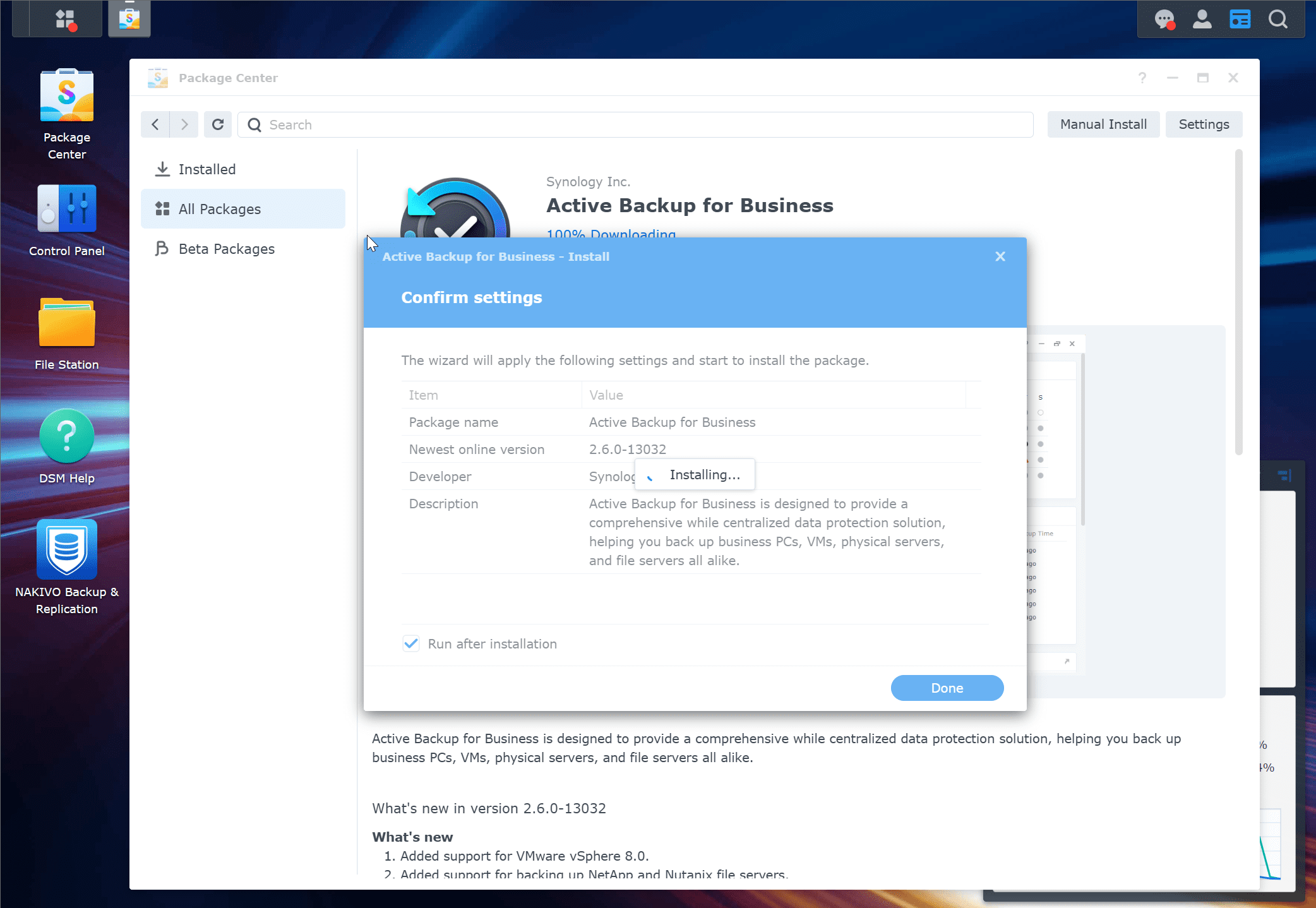
They added vSphere 8.x support in version 2.60-13032
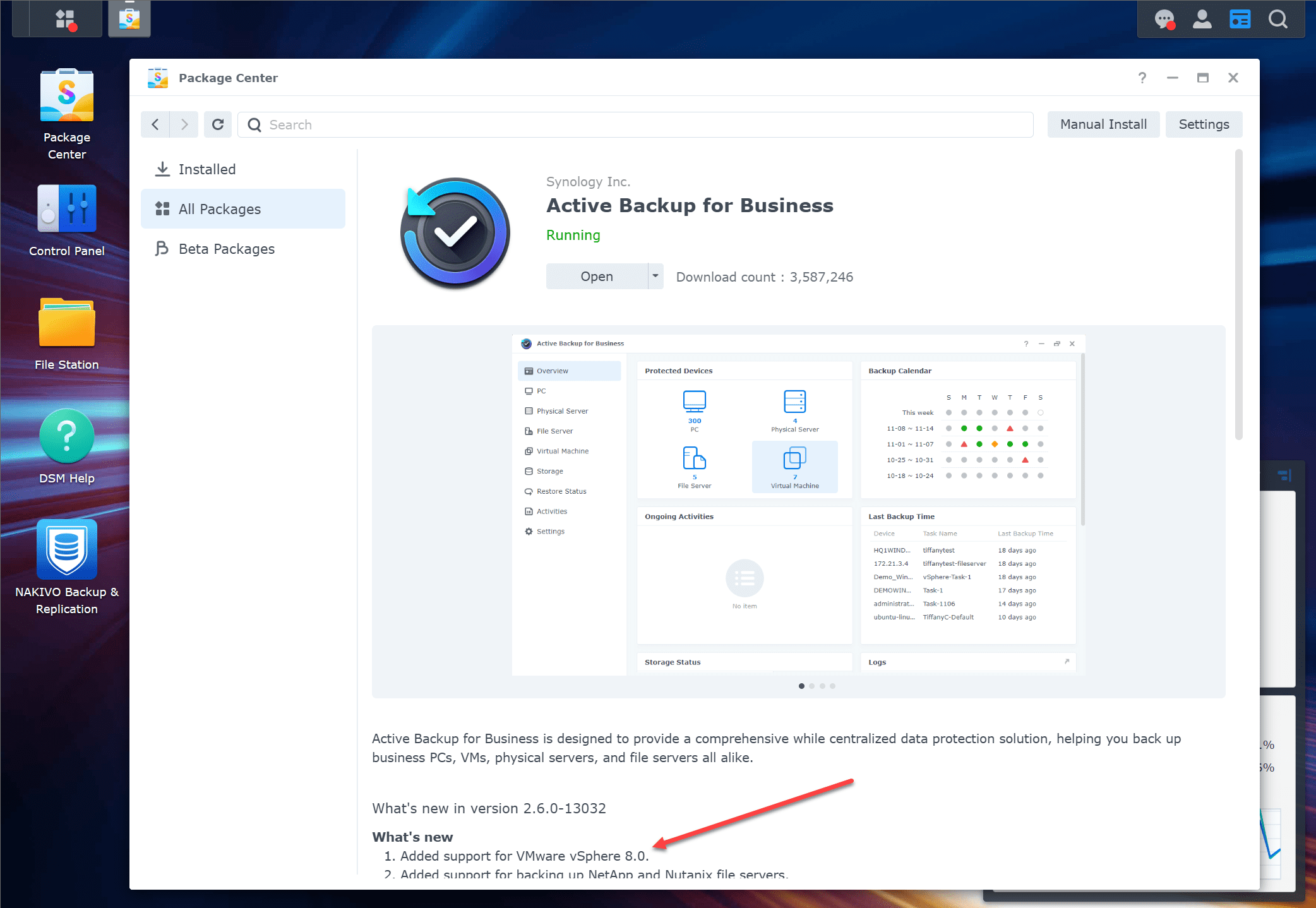
Latest at the time of this writing is 2.6.2-23081
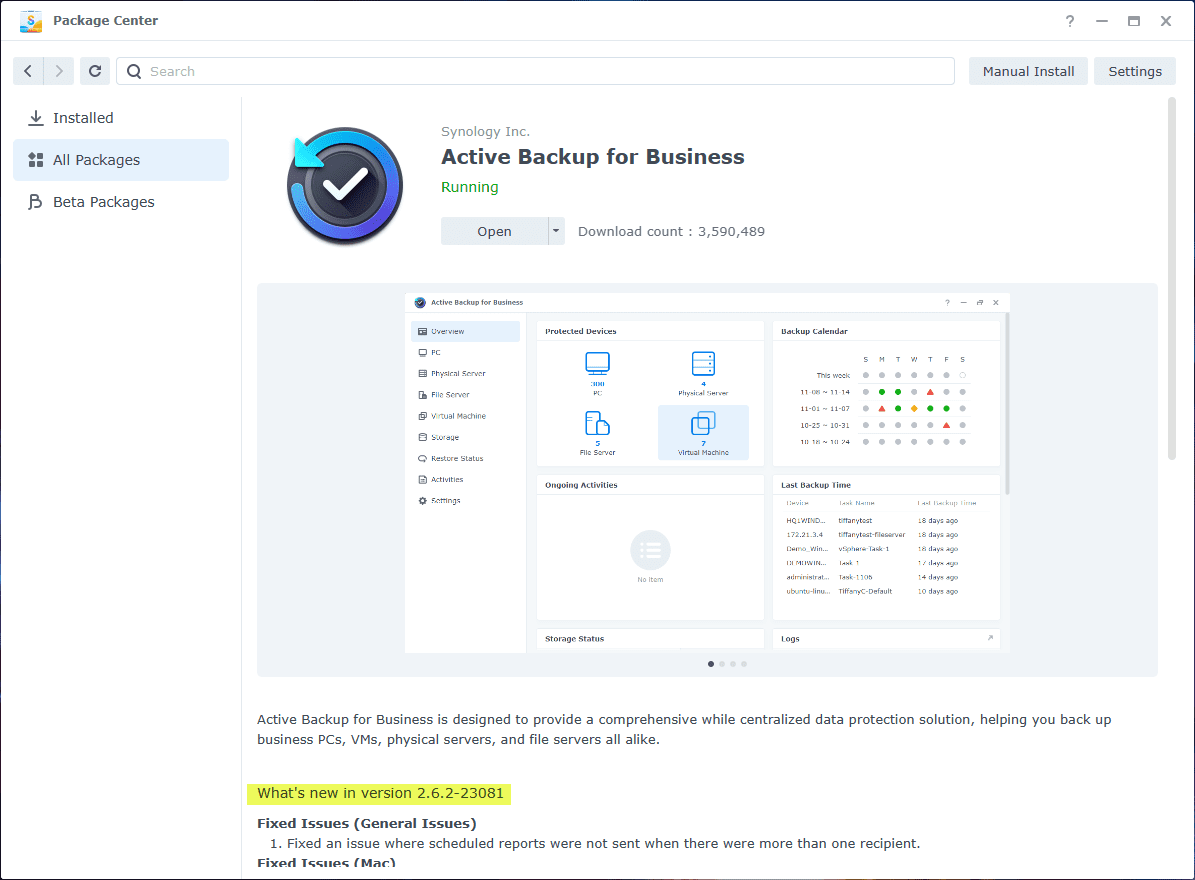
Accept the EULA/privacy statement.
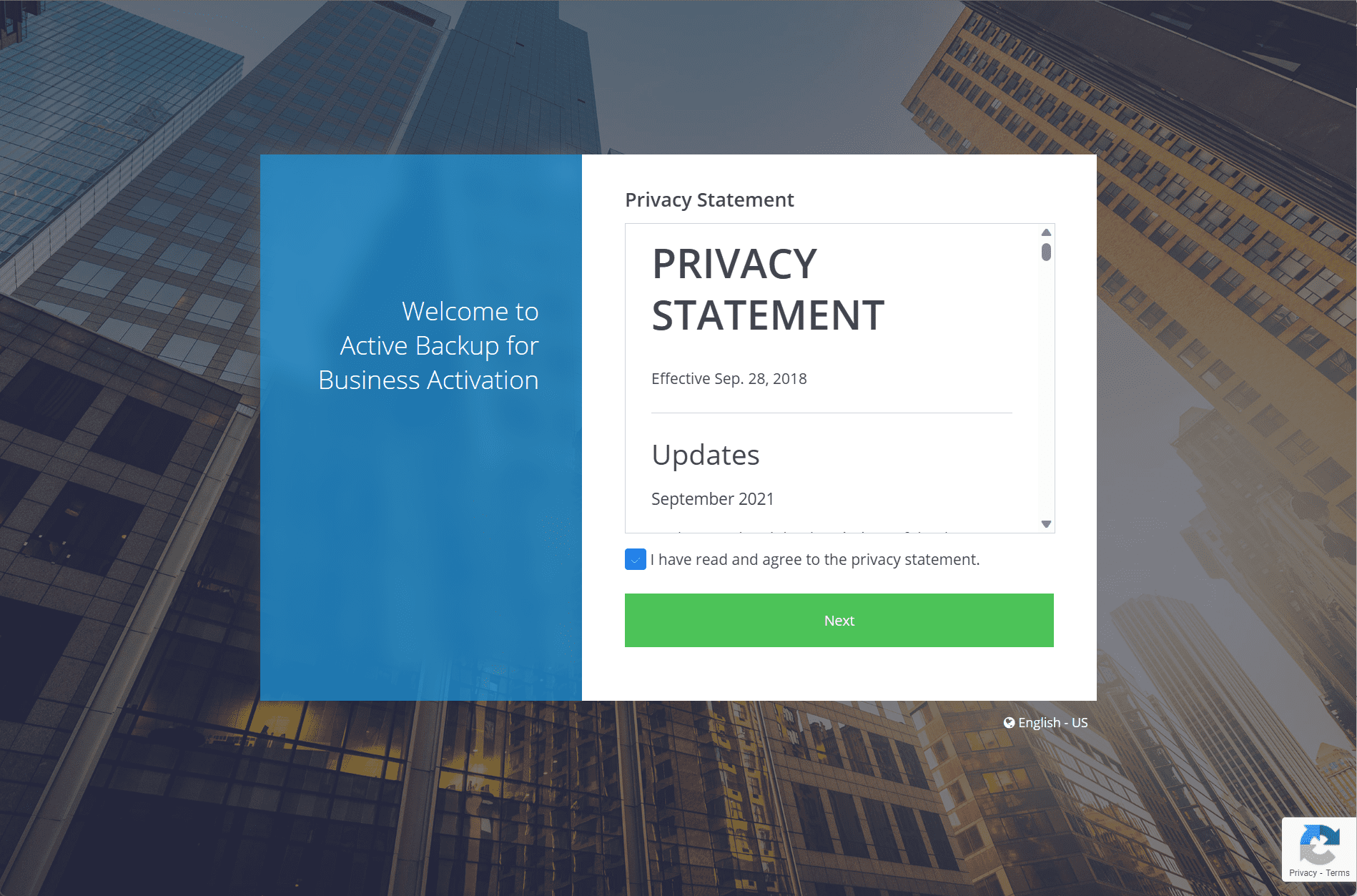
After logging into the Synology account and activating, Active Backup is activated.
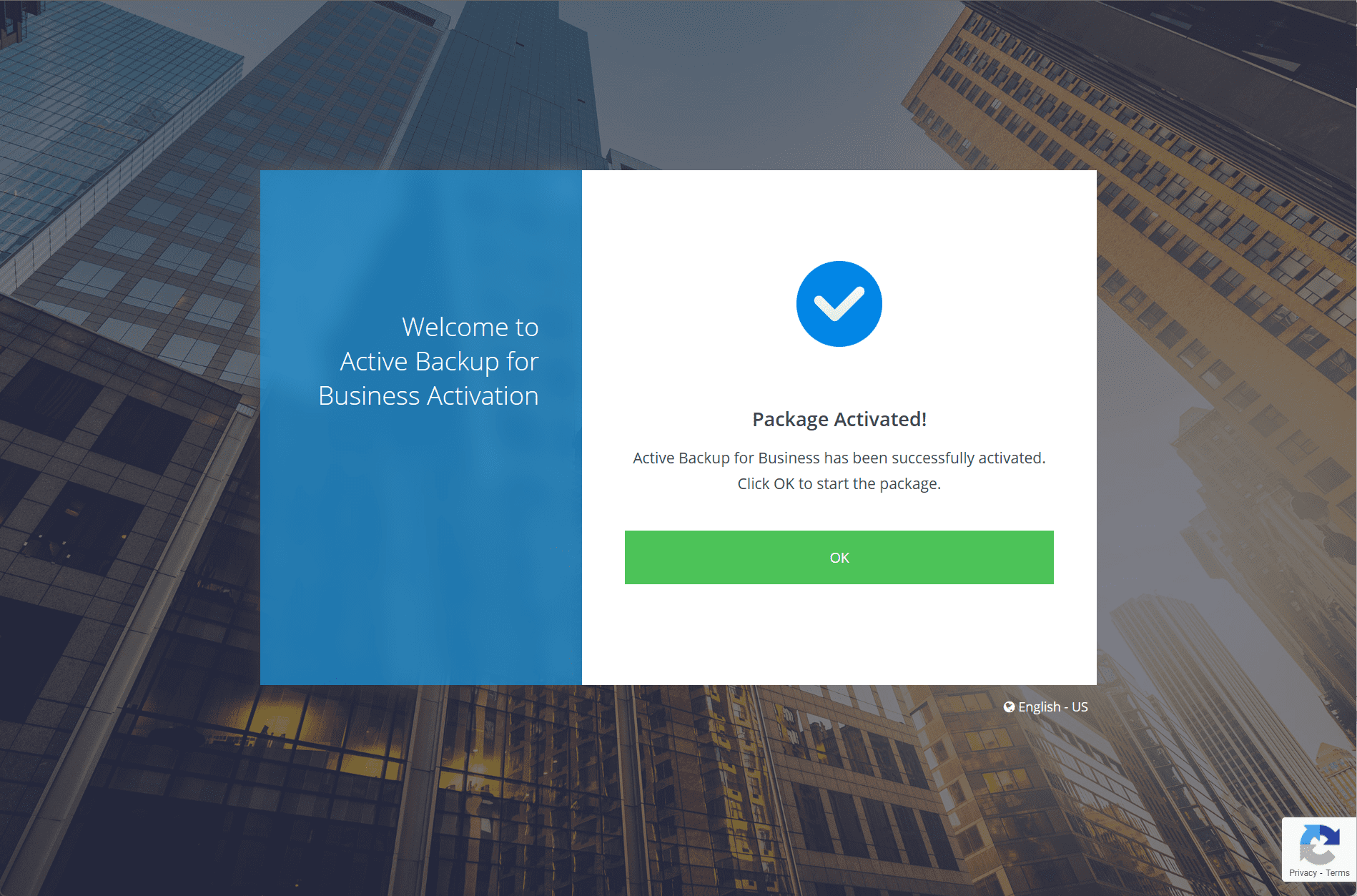
The latest version at the time of writing.
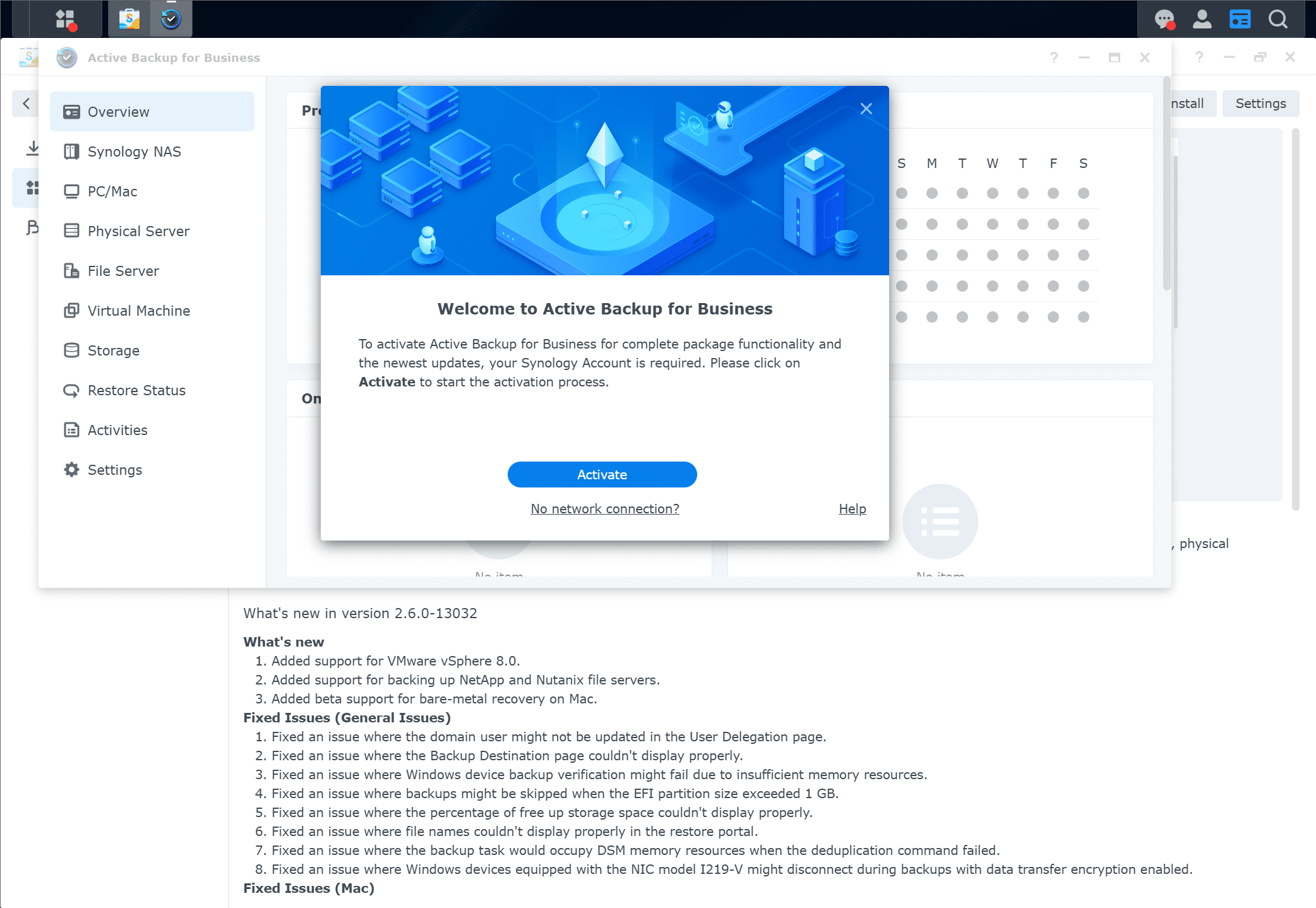
2. Backing up a virtual environment with Synology Active Backup
The first step to backing up your virtual environment with Synology Active Backup is adding the virtual environment. Navigate to your hypervisor you are using in the top ribbon, either VMware vSphere or Microsoft Hyper-V. Virtual Machine > Manage Hypervisor.
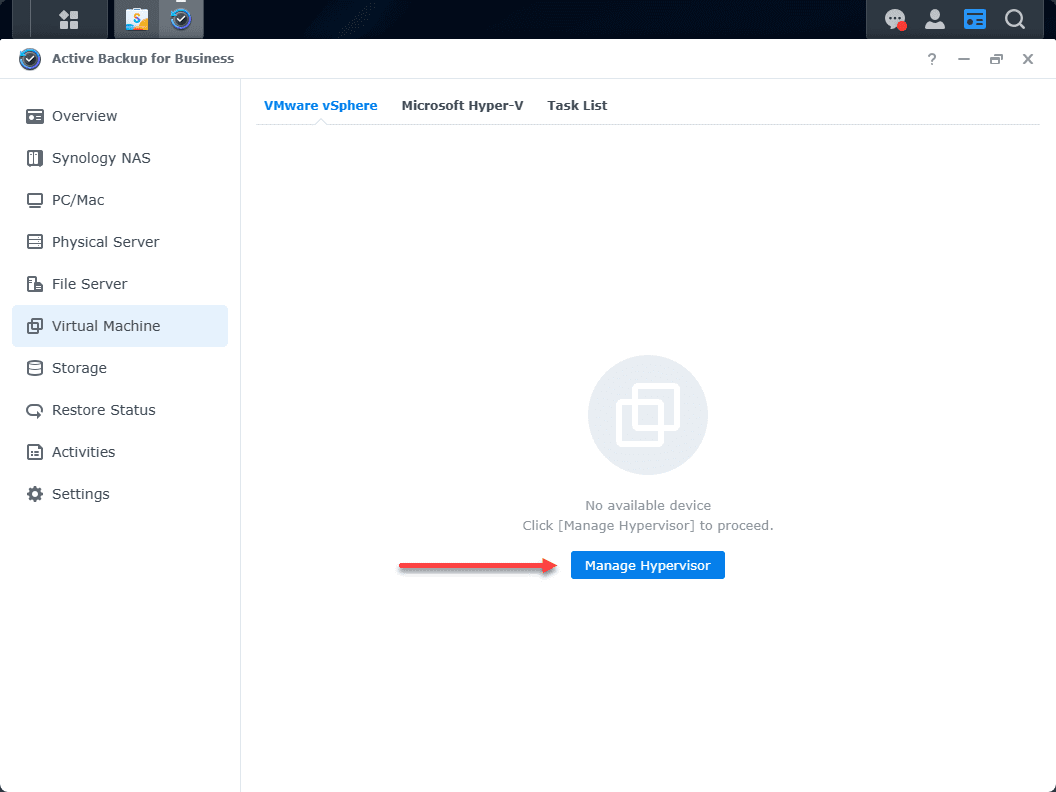
Click Add to add your ESXi host or vCenter Server.
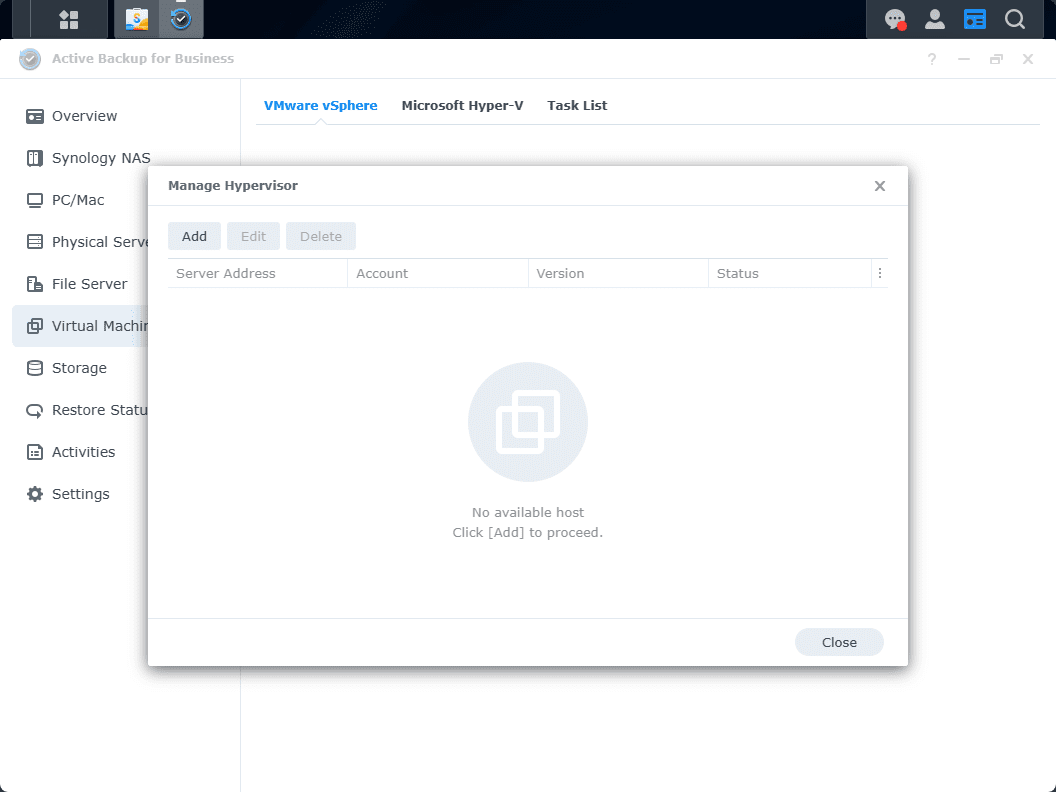
You will enter the details for your ESXi/vCenter Server connection:
- Server address
- Web services port
- Account (username)
- Password
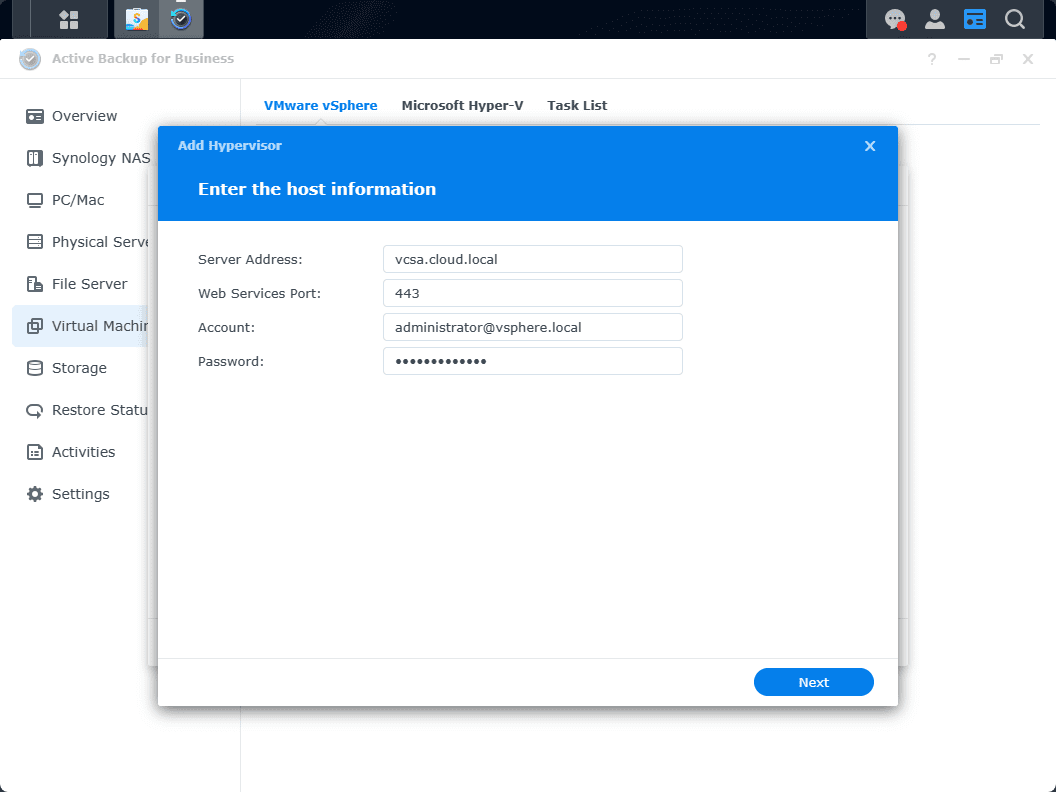
If you are using a self-signed certificate, you will need to accept the SSL certificate.
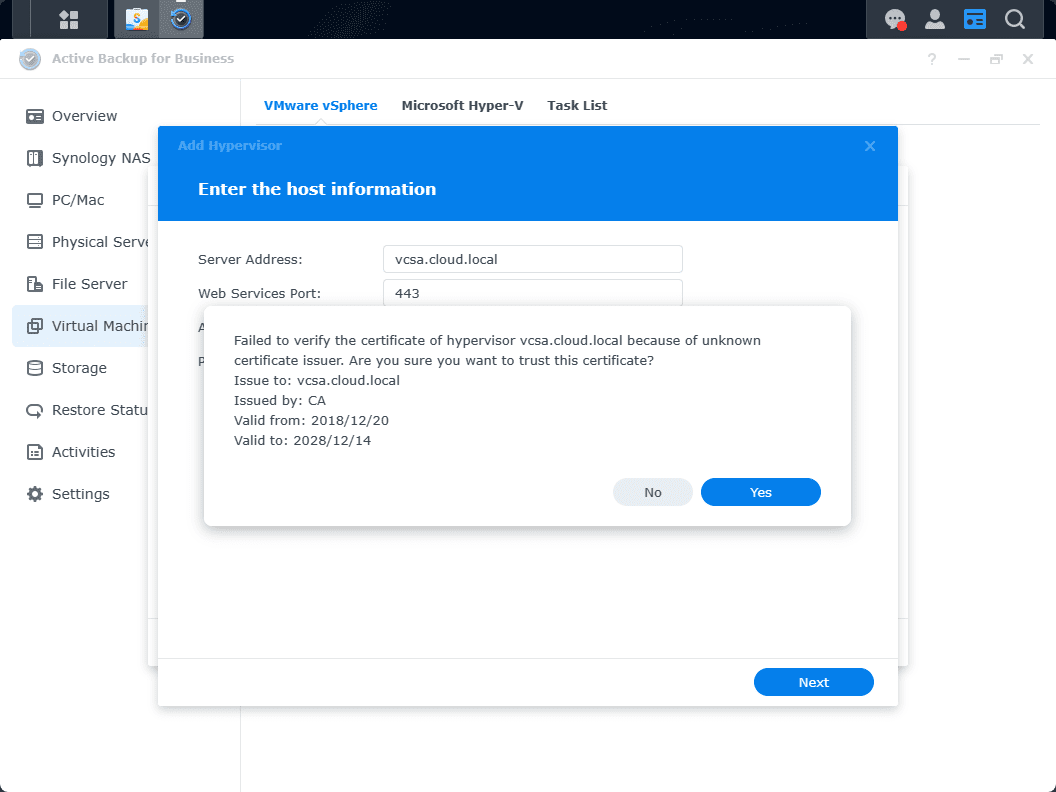
You should see successful checks with your vSphere Server.
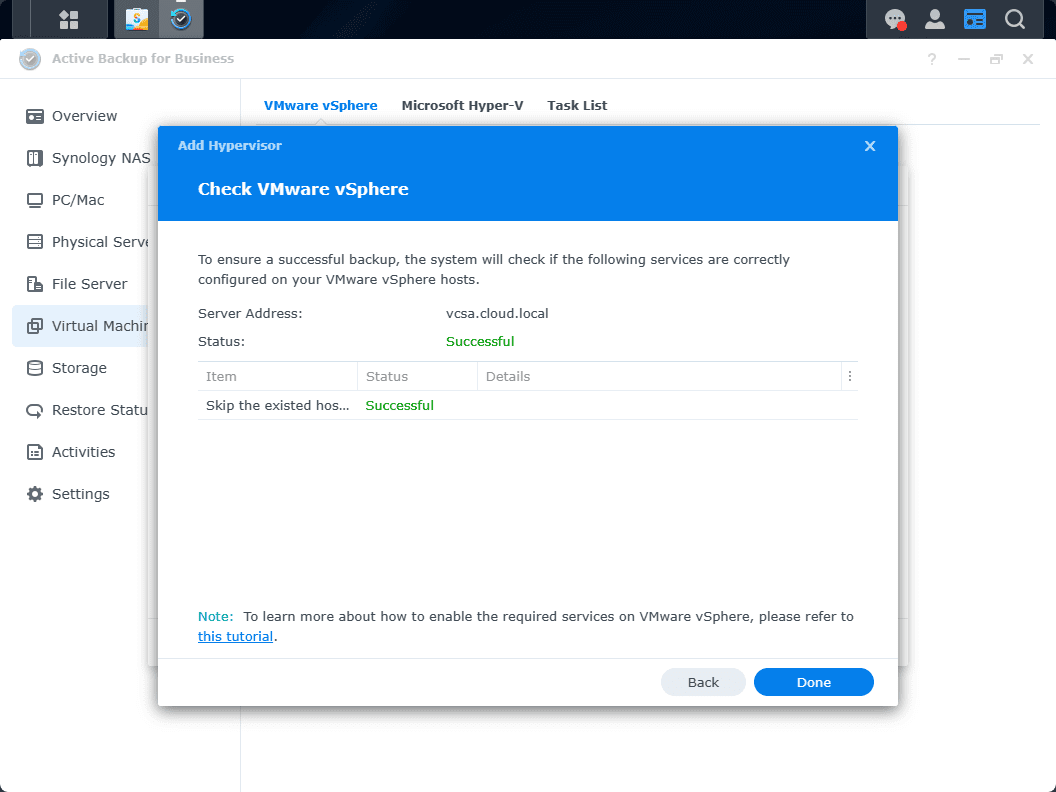
The vCenter Server connection is added successfully.
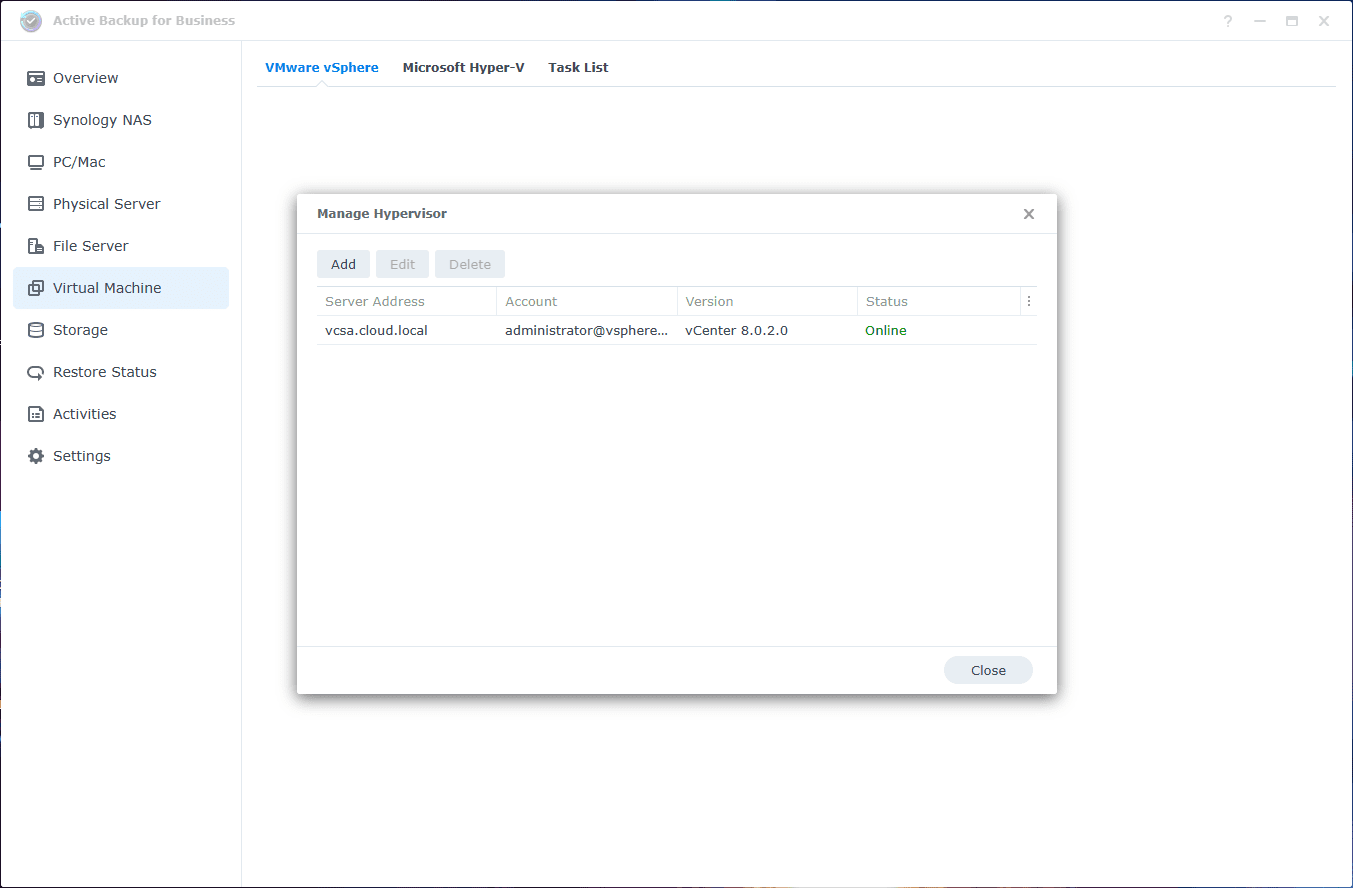
3. Creating a backup job
To create a new backup job, Active Backup calls this a Task. On the screen now, we see Active Backup is pulling the VMs from the environment. Click the Create Task button.
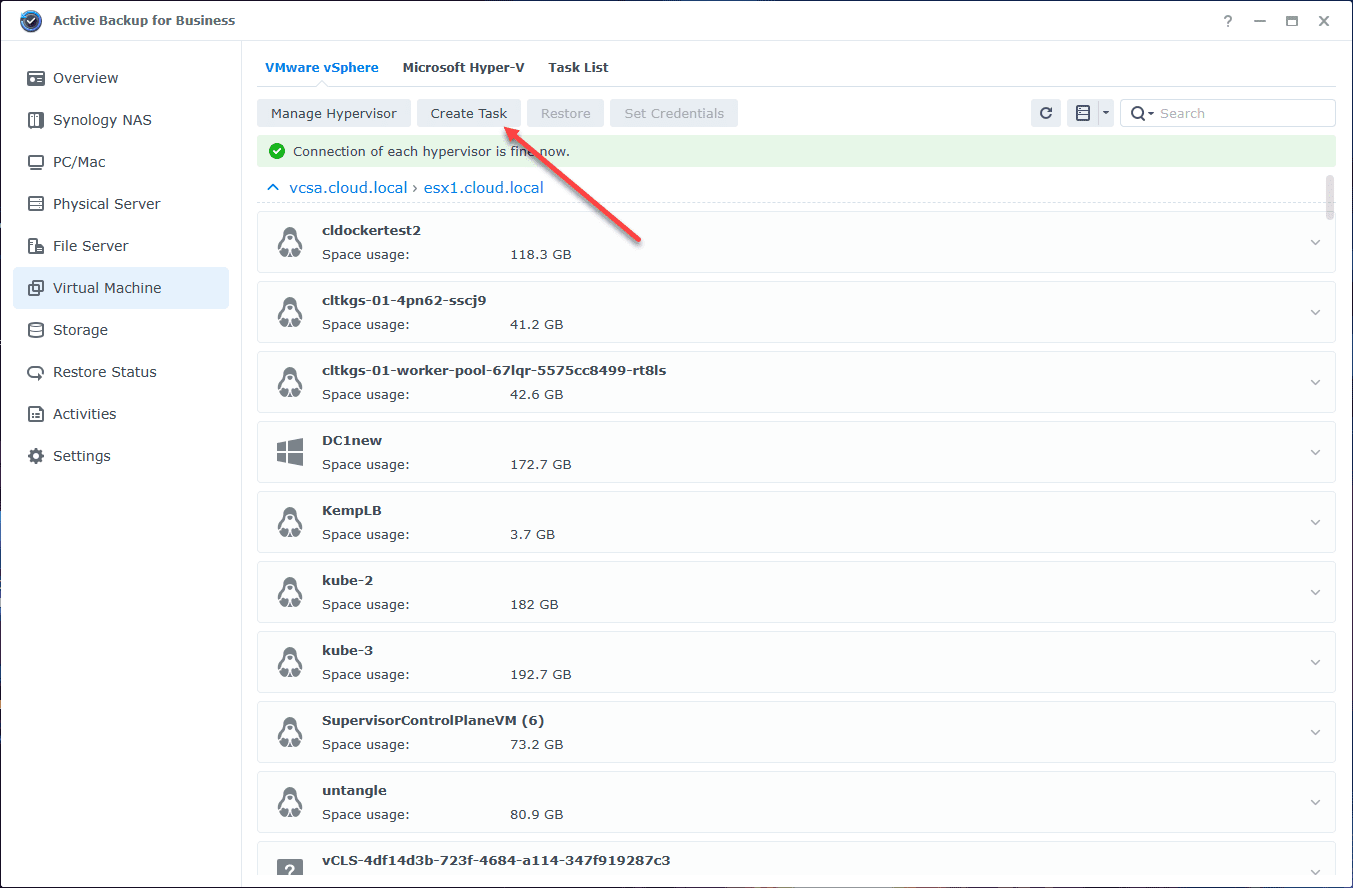
Select the object or objects you want to include in the backup task. Active Backup like other enterprise backup solutions allows choosing hosts or VMs, multiple VMs.
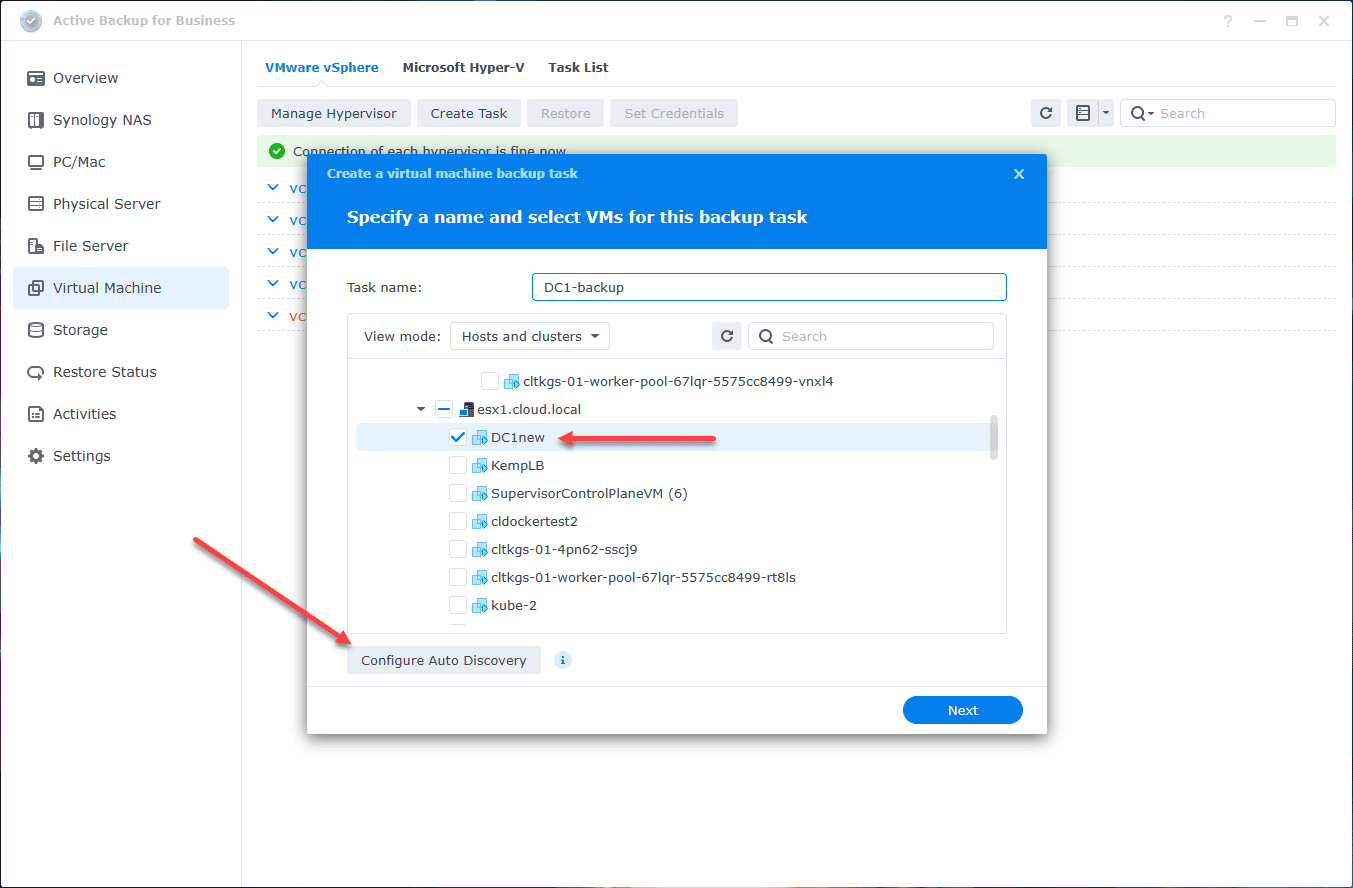
Active Backup also has a feature called Auto Discovery. This helps to take the heavy lifting out of adding new objects to the backup task. It will look for new VMs added to hosts or folders and automatically add them to the backup task.
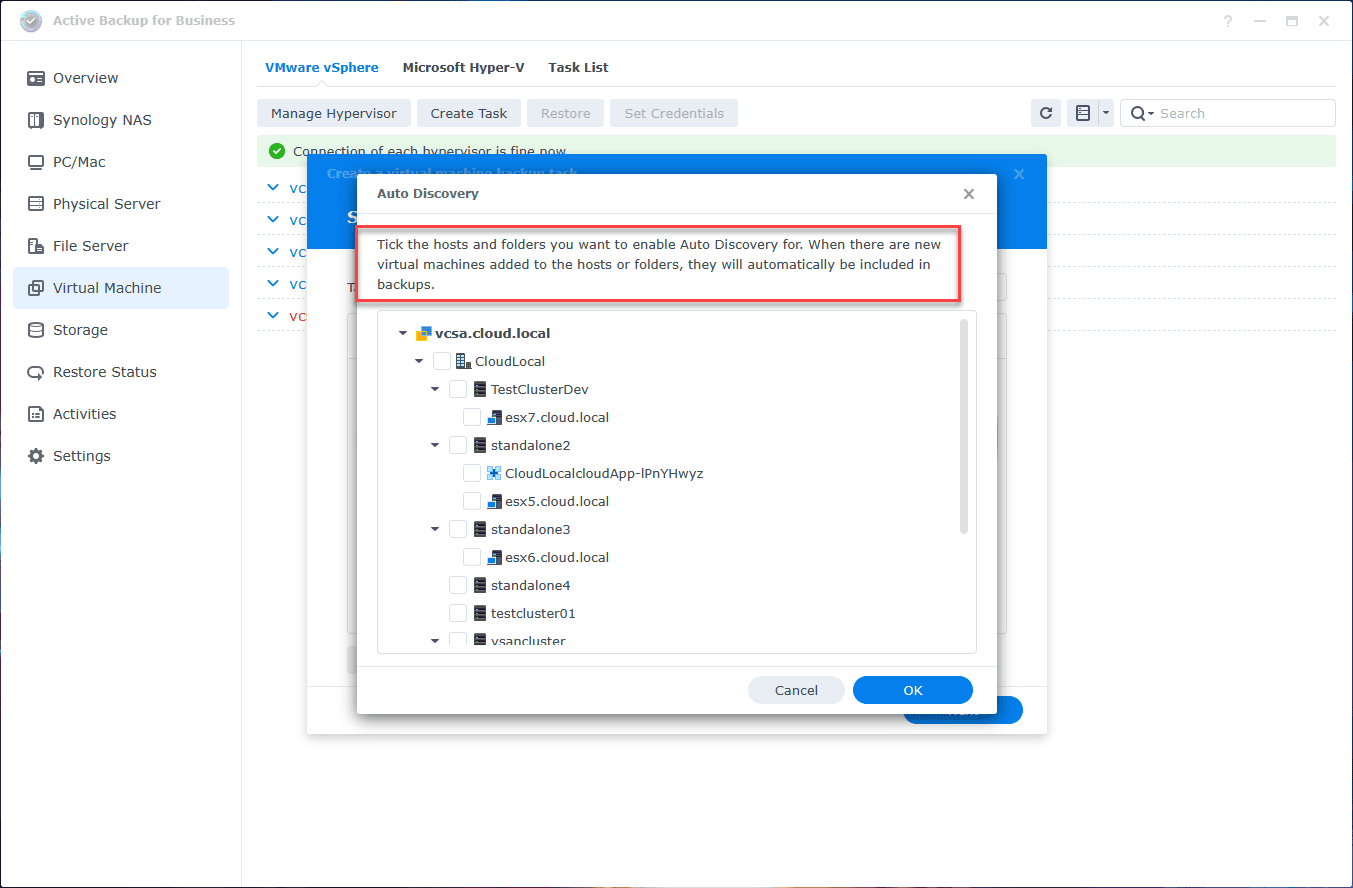
Next, Active Backup will ask you to choose the shared BTRFS folder storage space where you want to store the Active Backup data backup files (These are presented by folder sharing). You will see the datastore storage available made up of your drives hosted in the Synology datastore like any other service.
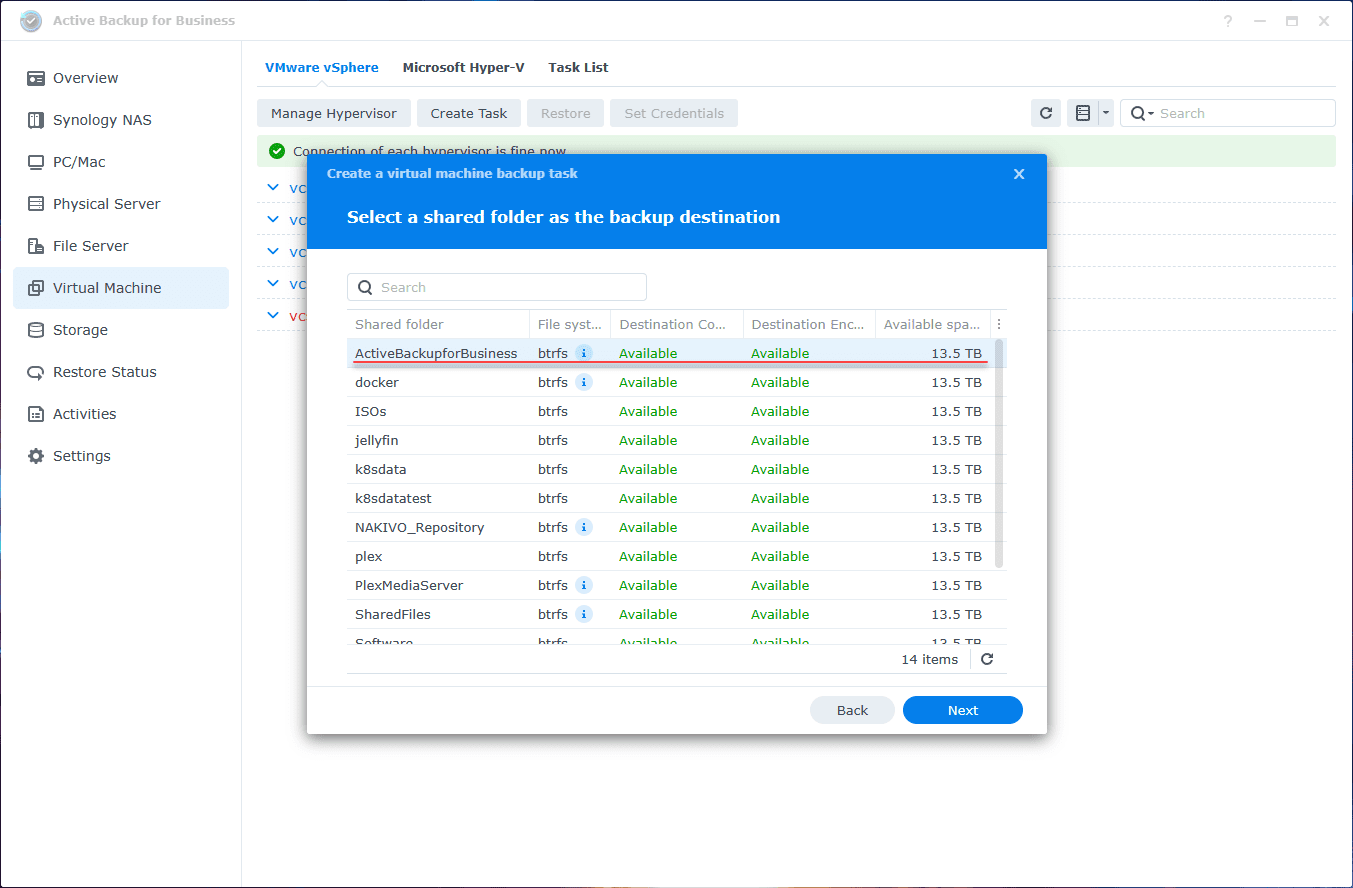
Next, you can enable compression and encryption.
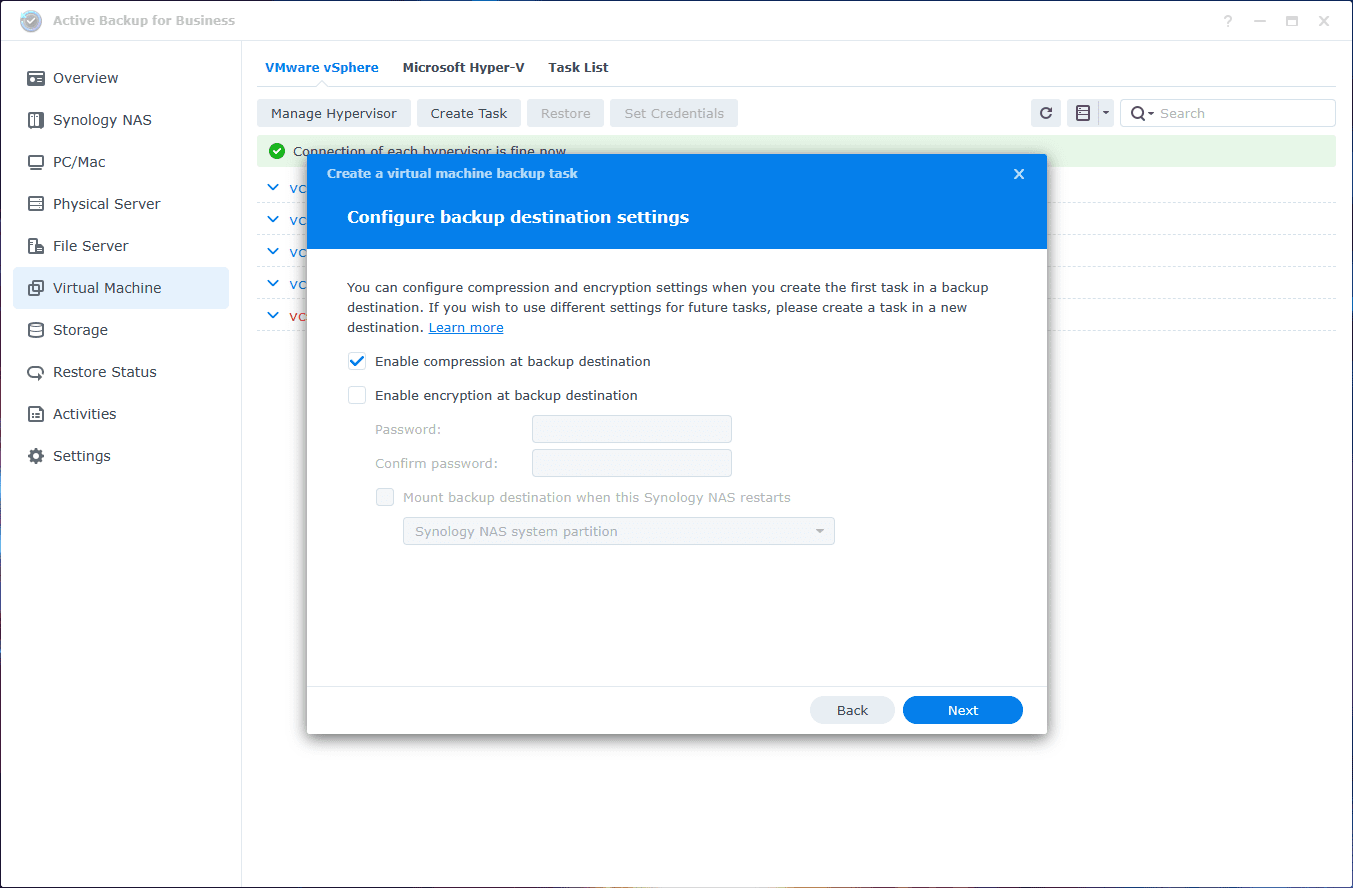
On the task settings, you have the following choices:
- Enable changed block tracking
- Enable application-aware backup
- Enable data transfer compression
- Enable data transfer encryption for security
- Enable VMware vSphere datastore usage detection
- When free space is less than X% backup will fail – Helps prevent the remote datastore from experiencing disk pressure due to open snapshots from backup operations.
- Enable backup verification
- Take live video for X seconds
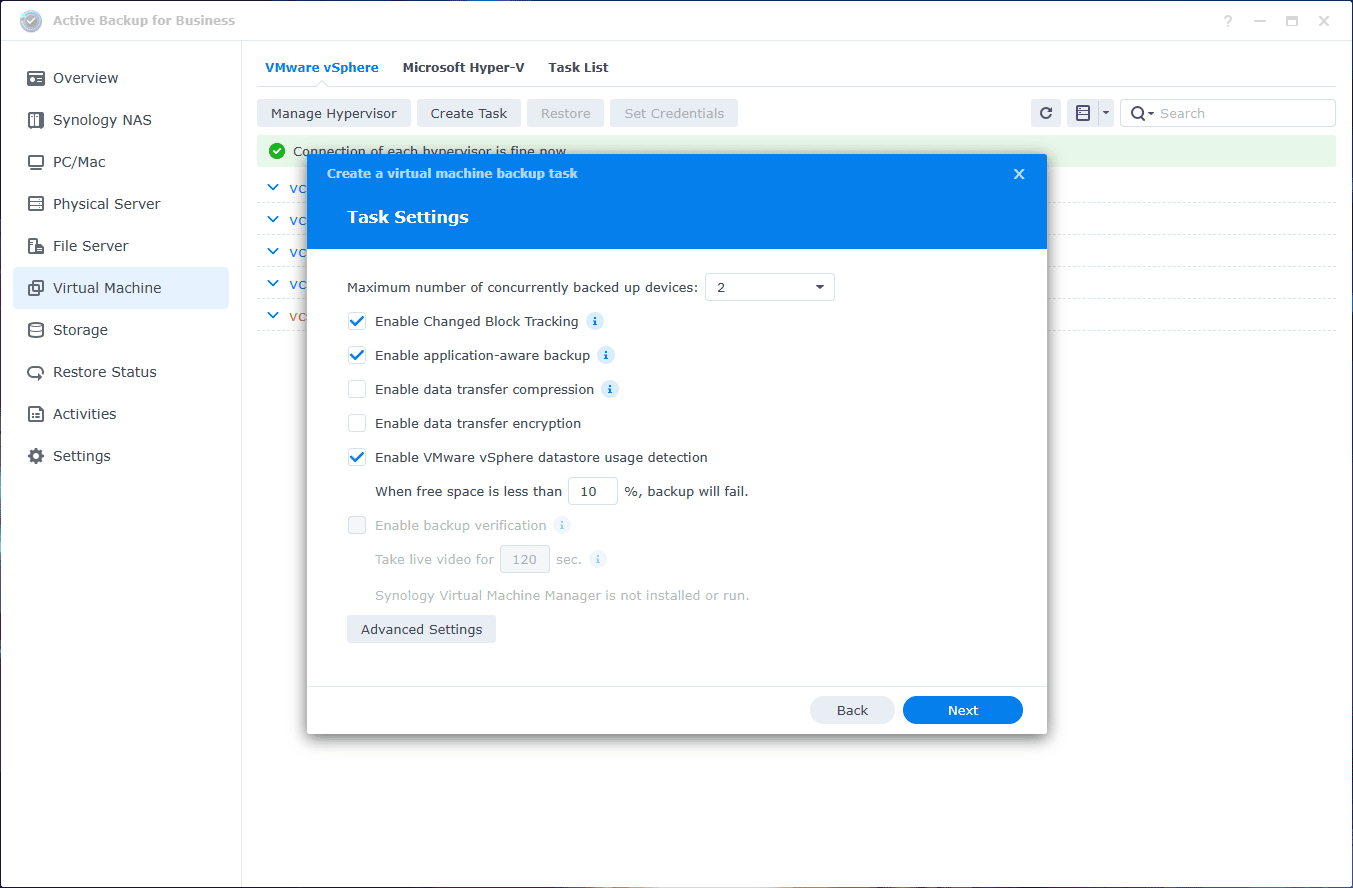
On the Advanced Settings screen, you can add credentials for the application-aware process and also select additional scripts you would like to run. Application-aware backups use VSS technology to ensure data is flushed correctly to disk file system before the backup happens. This allows applications like SQL server to be backed up in a consistent state.
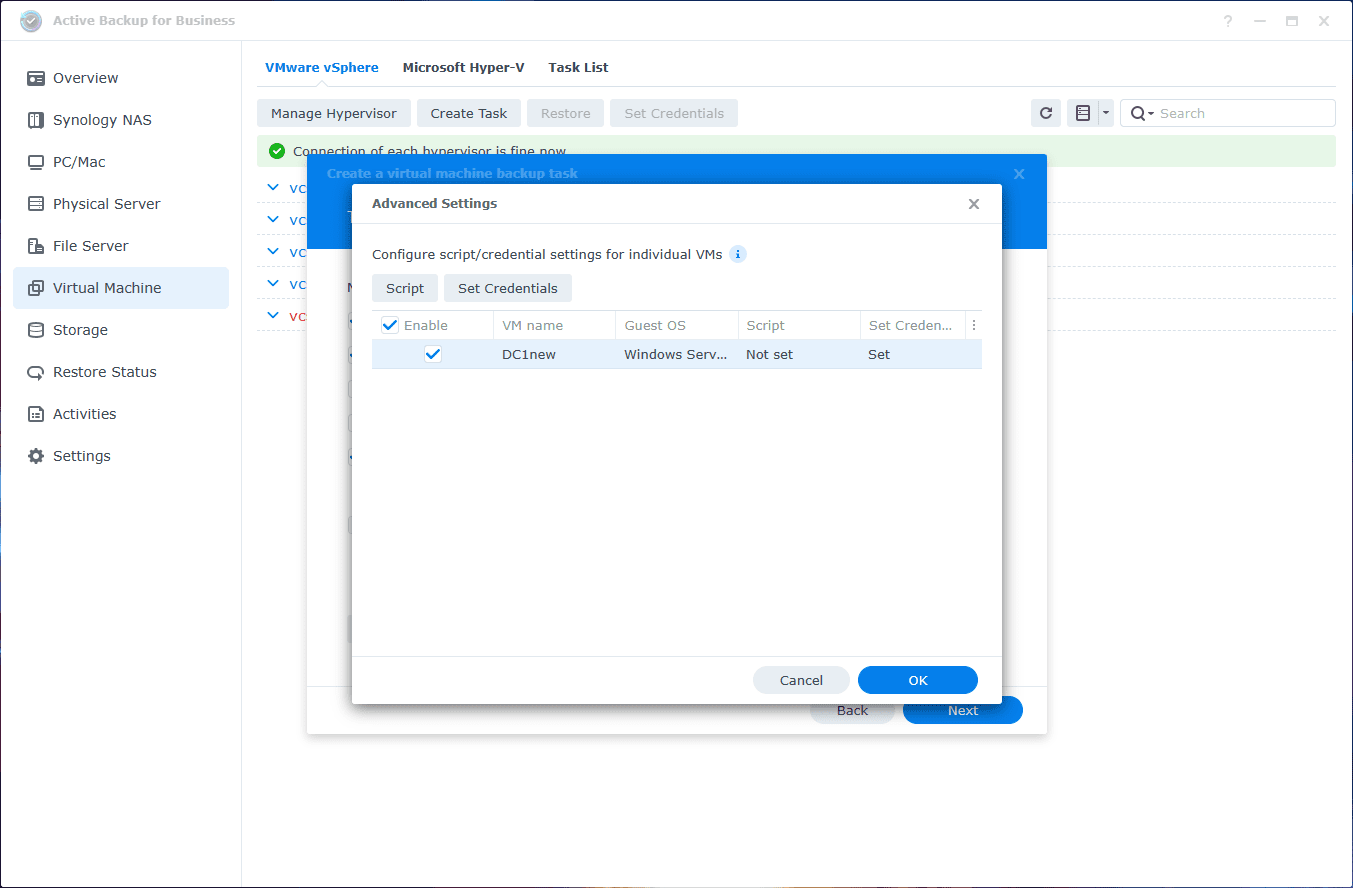
After we configure the advanced settings screen, the task will run some tests to make sure services are available on the VM.
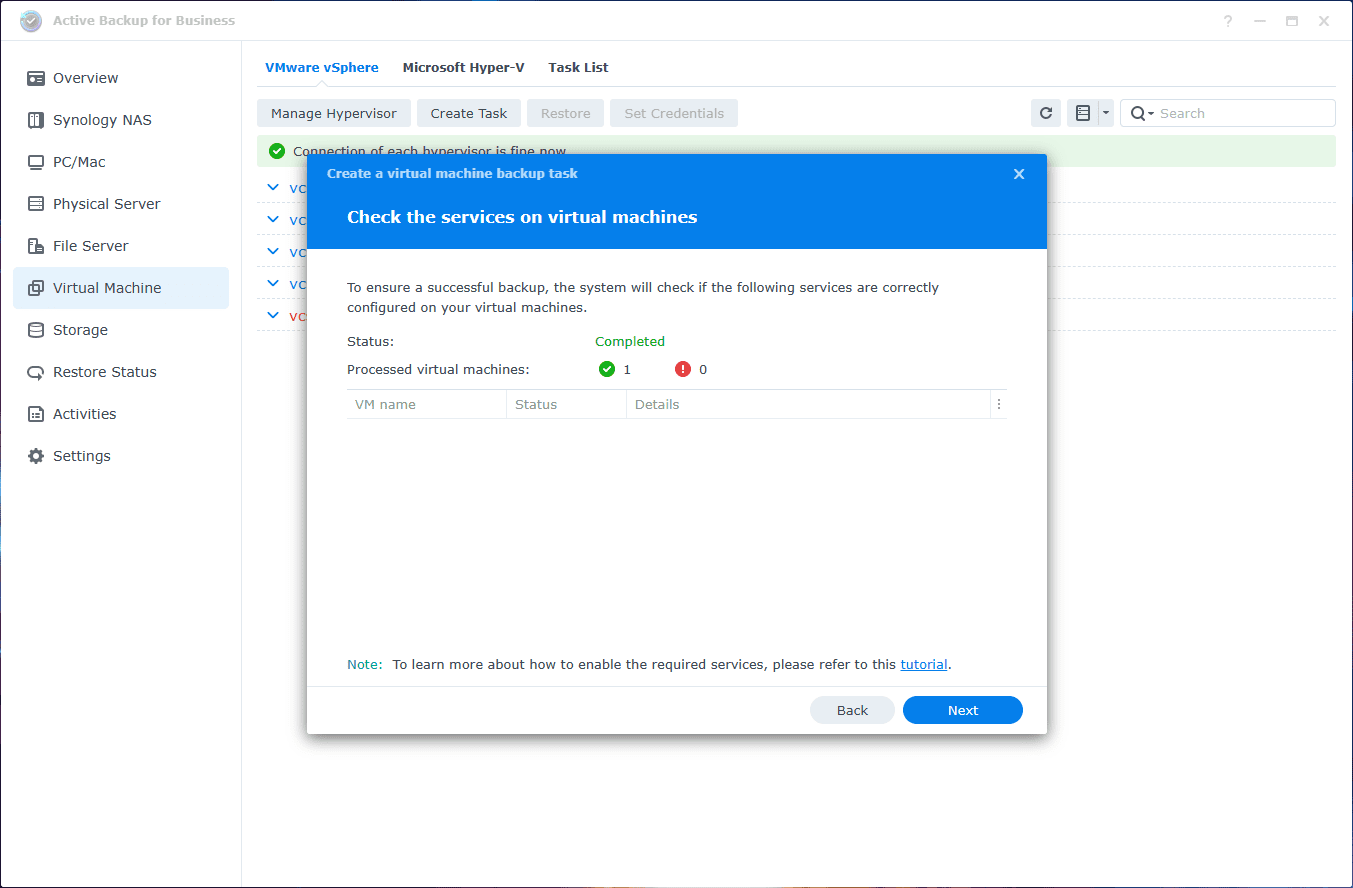
Next, we can choose if we want to run the backup manually or as a scheduled backup.
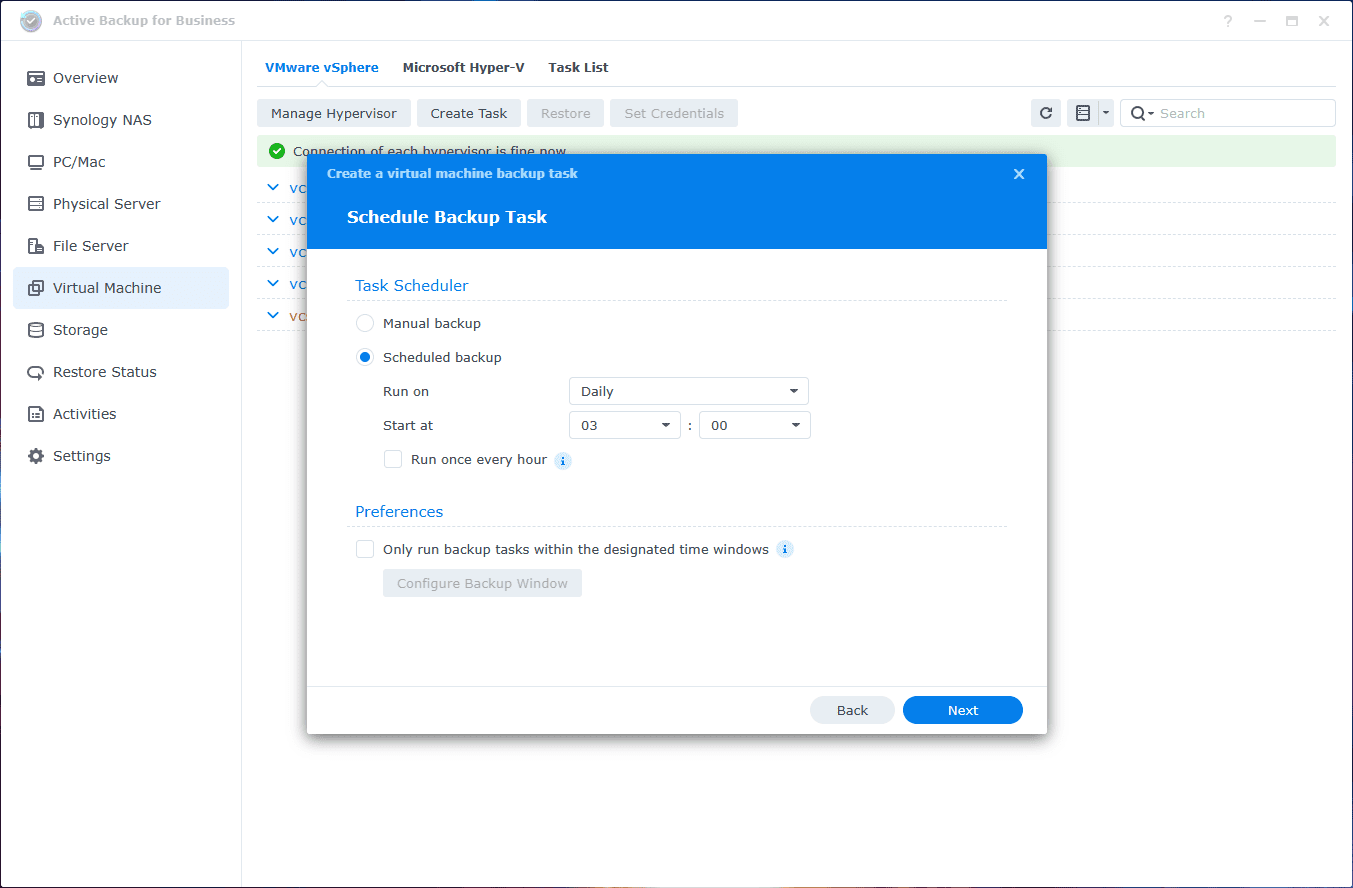
On the retention policy settings page you can configure the retention for the VM, either based on the number of restore points or based on time. This helps with storage consumption by pruning old backups that are no longer needed on the system.
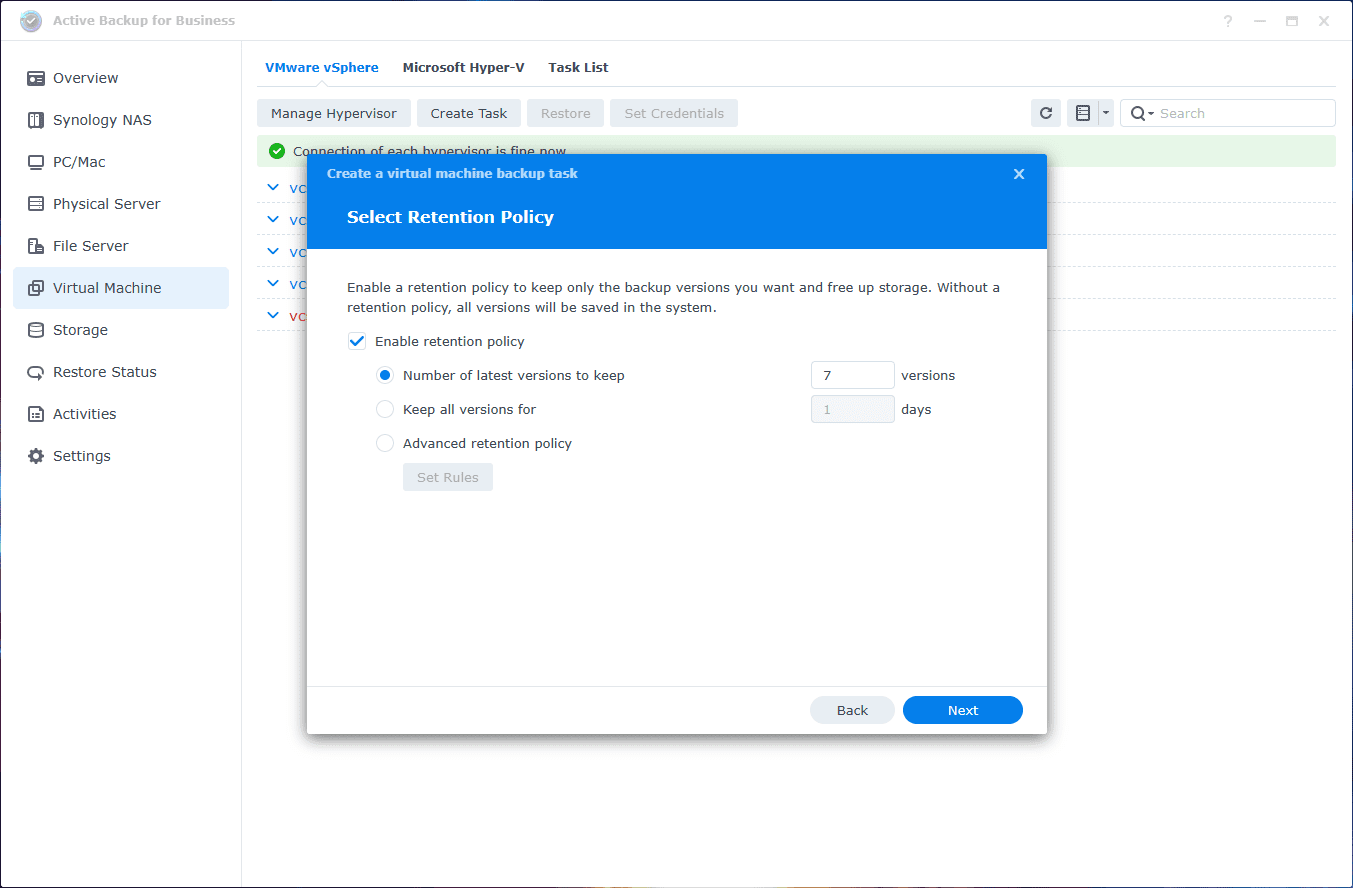
Finally, you can configure the restoration privileges for self-service restore services for a virtual resource.
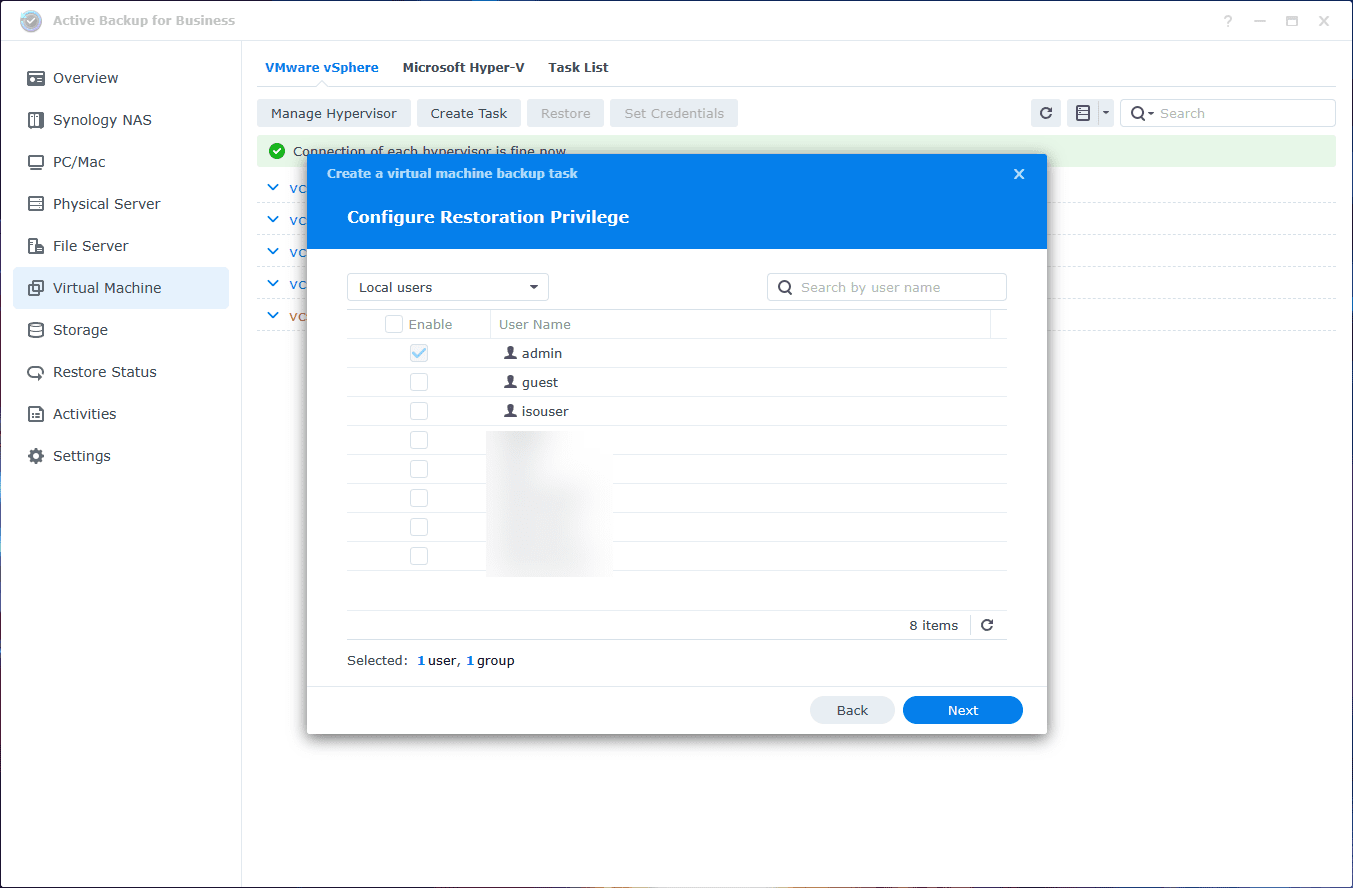
At the end of configuring the backup task, you will see the Task summary.
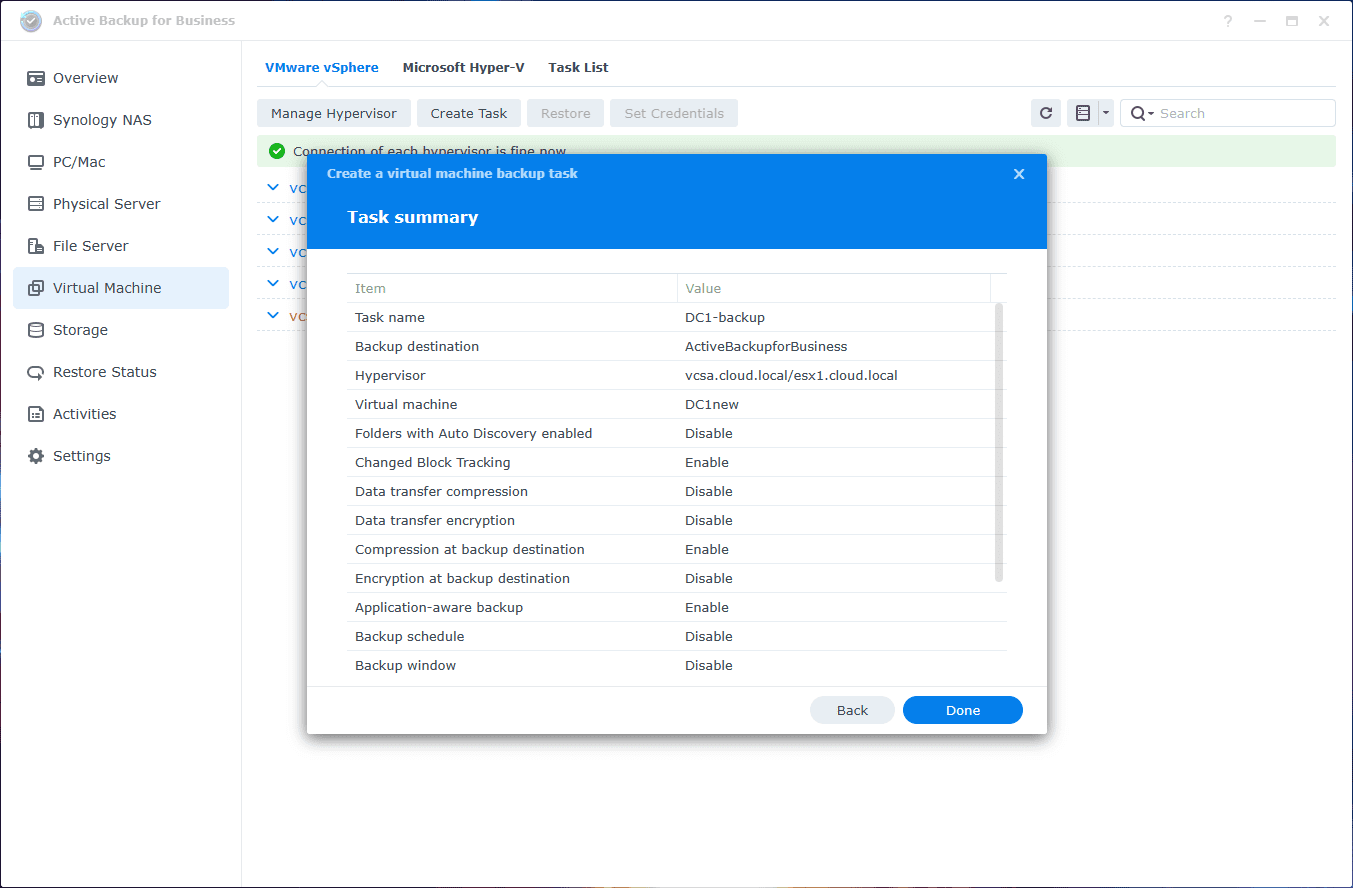
You will see the Back up now dialog where you can select to run the backup job as soon as you are done configuring the task.
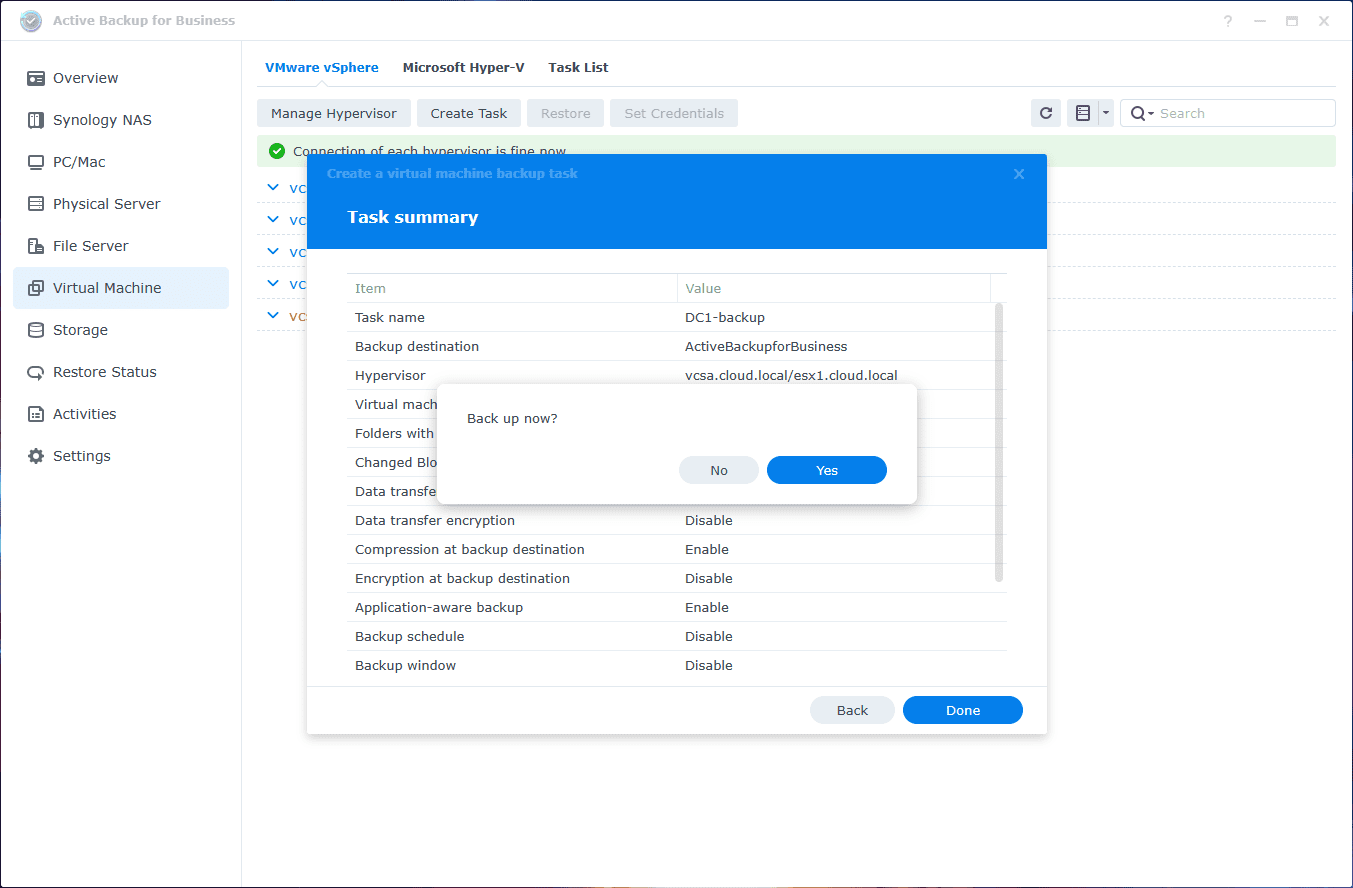
After selecting Yes, I hopped over to vCenter Server and see the snapshot getting created by Active Backup to back up the data.
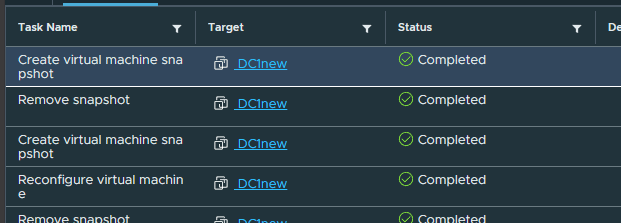
On the Task list screen, you can follow the progress of the backup job.
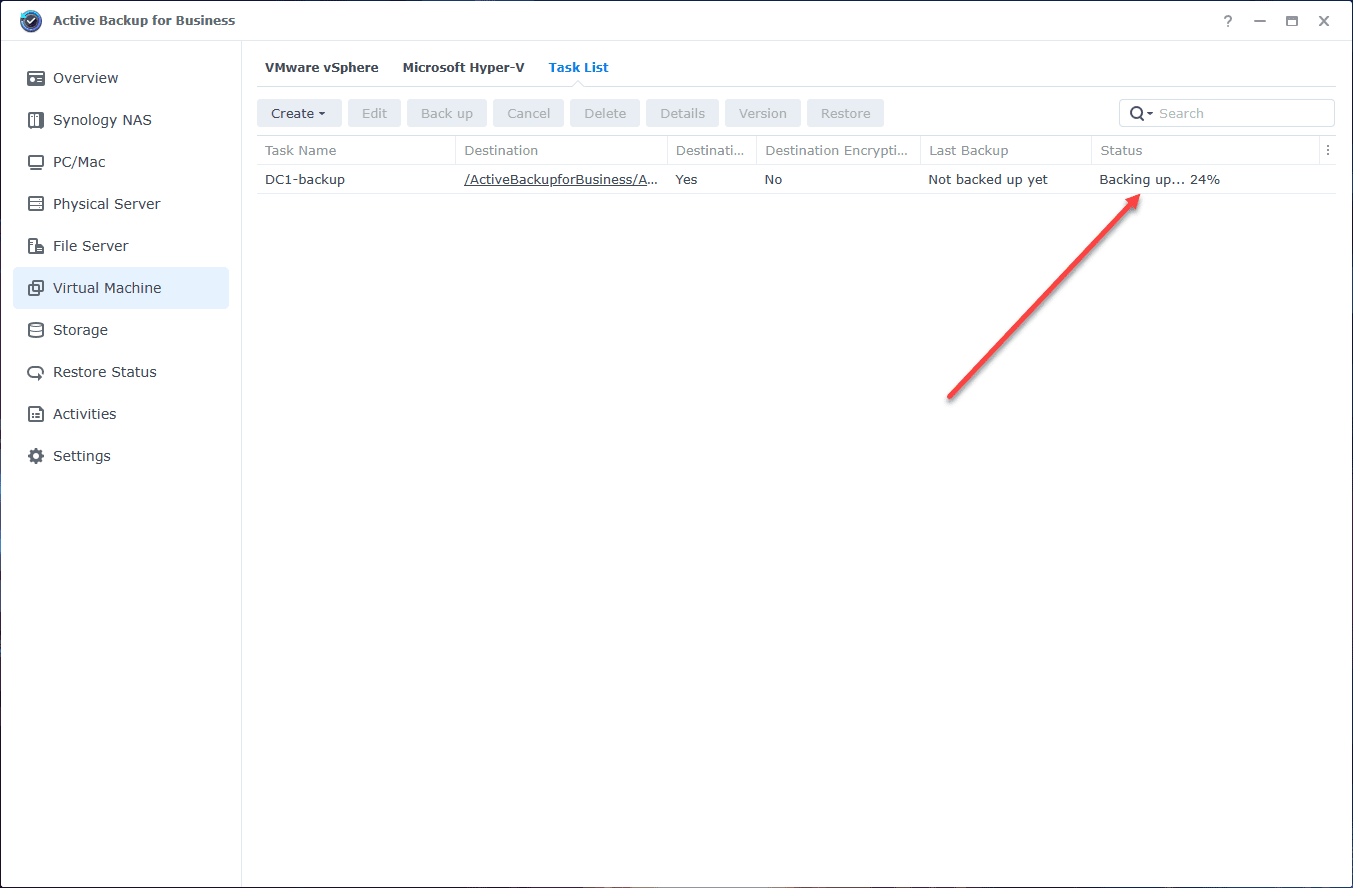
After the backup is finished, you will see a green check by the VM that is protected.
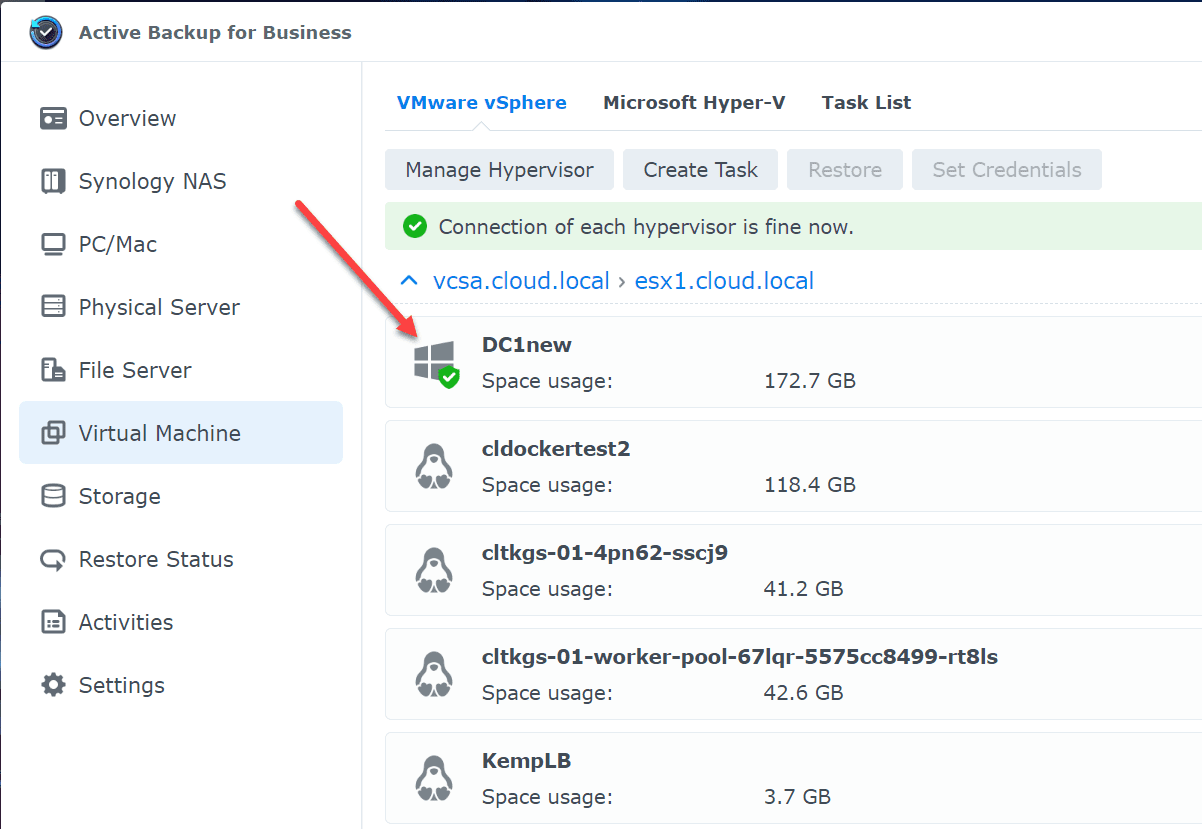
You can also view the details of the backup task, using the status tab or the more detailed log tab.
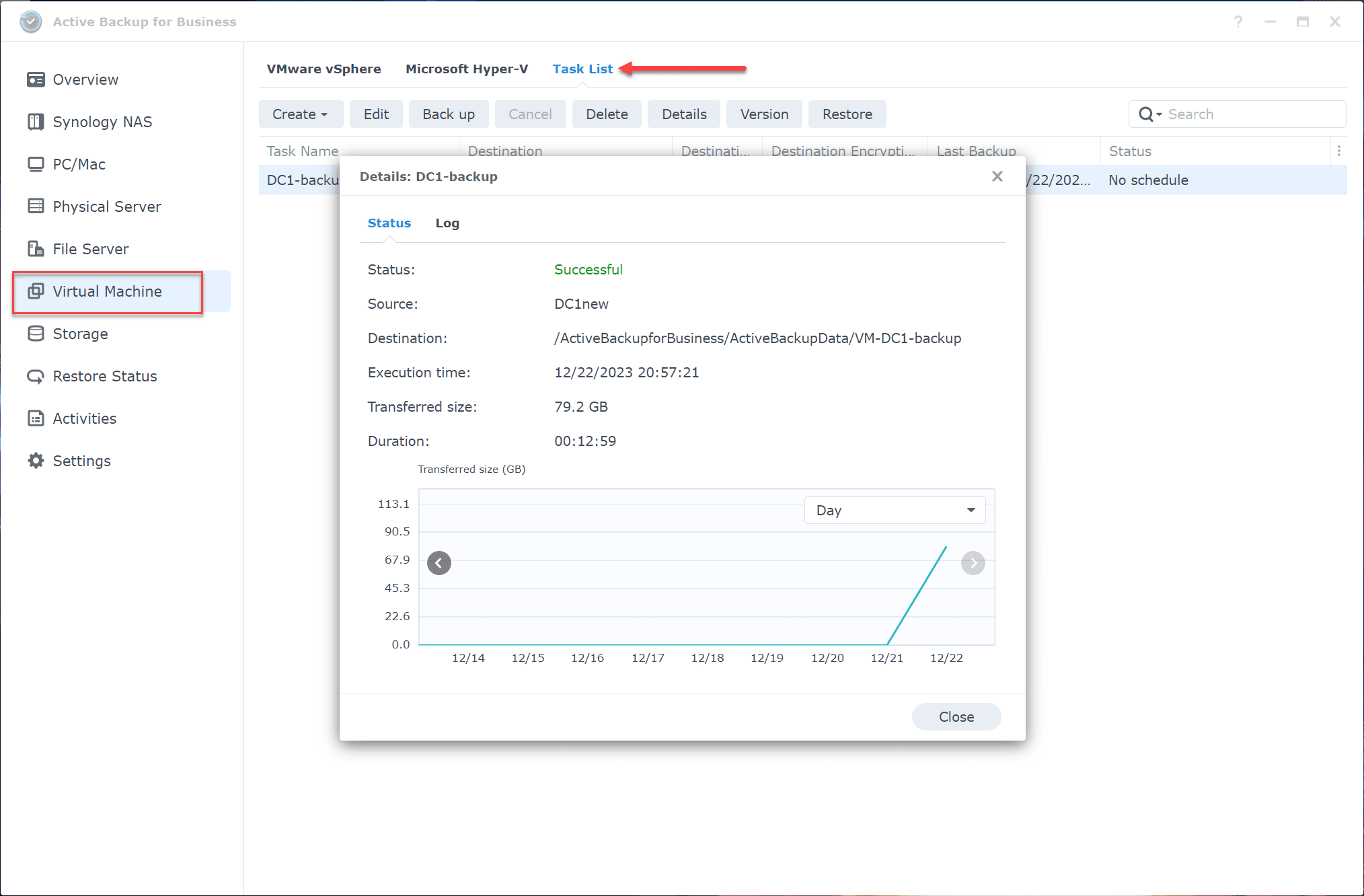
What are Active Backup templates?
Configuring backup settings in a template allows you to apply the same backup settings to multiple devices. The default backup template is always listed and cannot be removed.
When creating a template, you can select:
- backup type
- backup schedule
- compression settings
- encryption settings
- version retention policy.
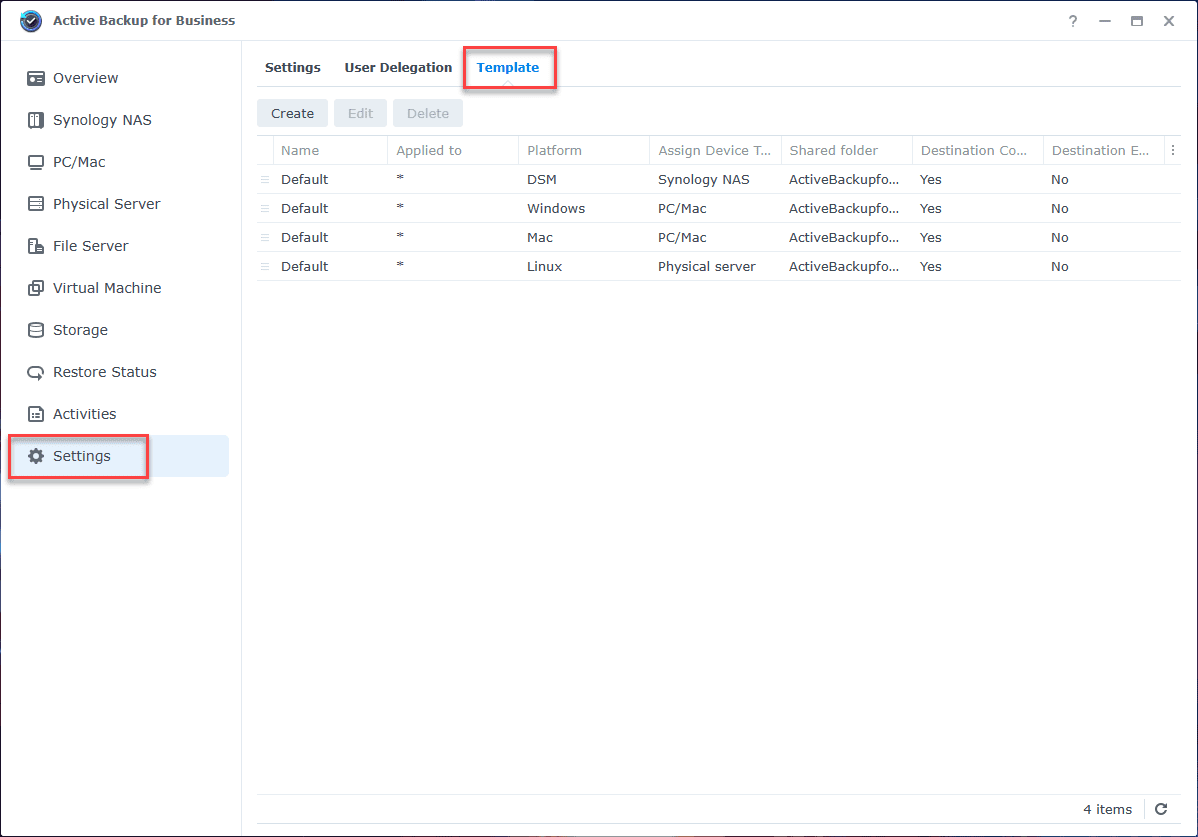
Why using a NAS is great for disaster recovery
Many home labbers and small businesses make use of Synology NAS devices. Using a NAS for disaster recovery is actually a really great idea since a NAS typically sits outside your normal server infrastructure. This in a sense places it outside of a failure domain. If you lose a server, you will likely still have your NAS up and running.
Also, another great advantage of using Synology NAS in your lab is that you get Active Backup for Business for free with your purchase of the Synology NAS diskstation hardware or other models. Arguably, you can’t get a more fully-featured backup solution for your home lab and network resources than Active Backup.
Many enterprise backup solutions have NFR licenses for vExperts and other partners. However, these are generally limited in the number of VMs and other resources you can back up. So, again, Active Backup is excellent.
Active Backup agent and Windows
Windows environments are extremely common. The Business Agent feature of Active Backup allows protecting physical Windows PCs and Windows Server. The setup and management of the Active Backup agent allows Active Backup to interact with the physical PCs and servers to protect your data with the backup process.
When you go through the wizard to setup a new Physical server, there is a link to download the Active Backup agent for your platforms.
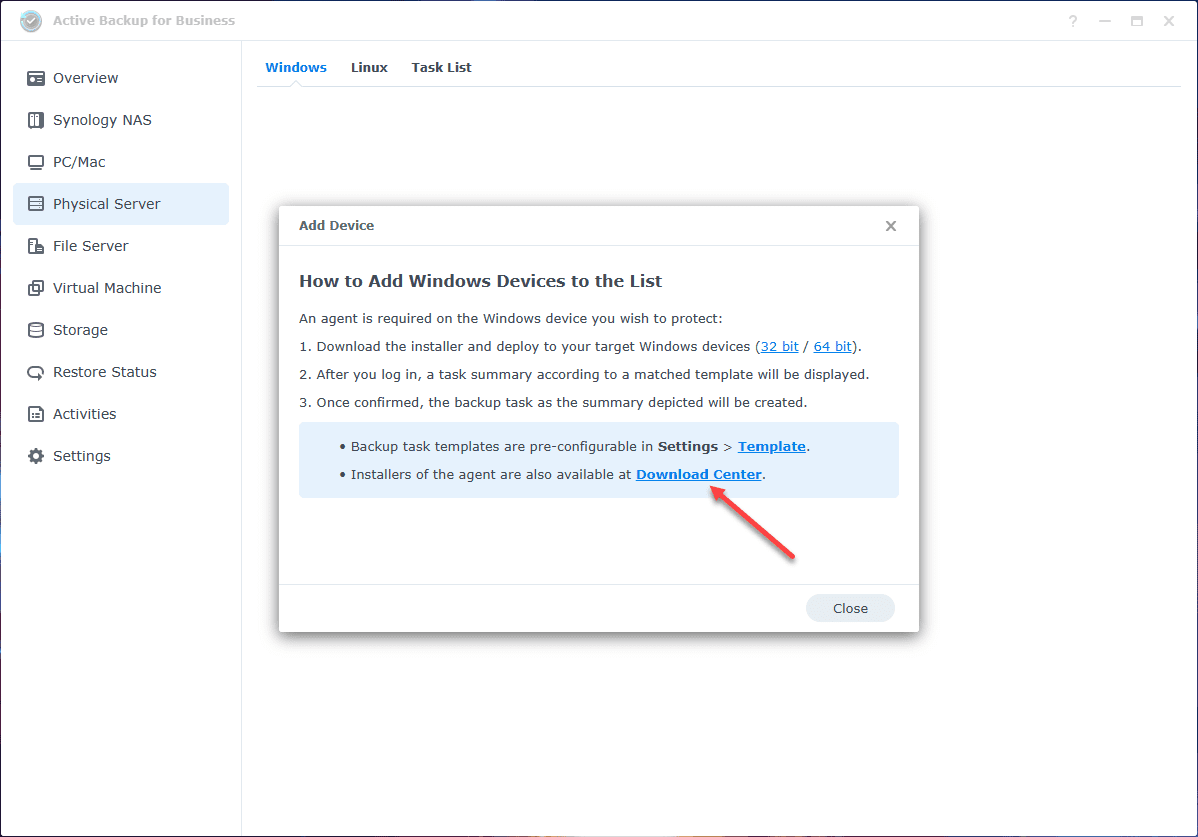
Download the Active Backup agent for your physical server.
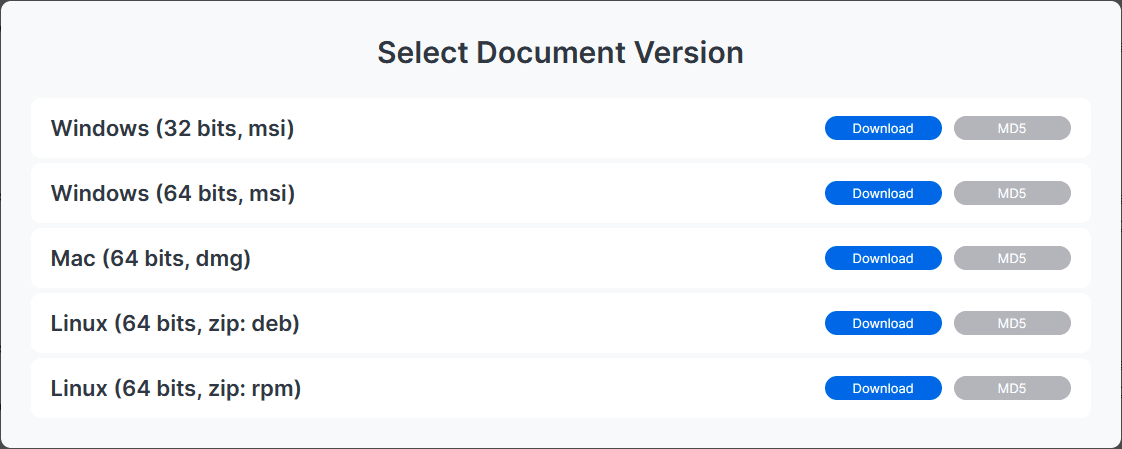
Wrapping up Synology Active Backup for Business
Synology’s Active Backup for Business is one of the best-kept secrets for backing up your home lab or for small businesses and their infrastructure. It has most of the backup features found in many of the enterprise backup solutions and it is still surprising to me that Synology does not charge for a license. While Synology NAS devices are more expensive than running TrueNAS and other solutions, I think part of the appeal is the software solutions and ecosystem you get with Synology, such as Active Backup for Business. For the home lab, this is a no-brainer.





